QUEEN ELIZABETH II NATIONAL TRUST ANNUAL REPORT 2022

ANNUAL REPORT 2022 OF QUEEN ELIZABETH II NATIONAL TRUST, NGĀ KAIRAUHĪ PAPA (QEII NATIONAL TRUST).
PRESENTED TO THE HOUSE OF REPRESENTATIVES PURSUANT TO SECTION 32 OF THE QUEEN ELIZABETH THE SECOND NATIONAL TRUST ACT 1977.
QUEEN ELIZABETH II NATIONAL TRUST is a statutory organisation independent from government and managed by a Board of Directors. We are a registered charitable entity under the Charities Act 2005. Registration number CC28488.
BOARD OF DIRECTORS
Chair Bruce Wills, Karen Schumacher, Alan Livingston, Neil Cullen, Donna Field, Graham Mourie.
CHIEF EXECUTIVE Dan Coup T 04 474 1683 E info@qeii.org.nz

Patron Her Excellency, The Right Honourable Dame Cindy Kiro, GNZM, QSO, Governor-General of New Zealand.
Queen Elizabeth II National Trust, PO Box 3341, Wellington 6140, New Zealand. Level 4, 138 The Terrace, Wellington T 04 472 6626 E info@qeii.org.nz W www.qeiinationaltrust.org.nz
FINANCE AND BUSINESS SERVICES MANAGER
Deirdre Parag
AUDITOR Sam Nicolle Ernst & Young Wellington On behalf of the Auditor-General
BANKERS Bank of New Zealand
SOLICITORS
Gibson Sheat Lawyers
INSURER
AON New Zealand ISSN 2324-5948
CONTENTS
CHAIR’S REPORT 04
CHIEF EXECUTIVE’S REPORT 06
WHO WE ARE AND WHAT WE DO 08
PARTNERING TO PROTECT LAND 09
PRIORITISING PROTECTION 10
PROTECTING THE LAND, FOREVER 12
THE STEPHENSON FUND 12
WORKING WITH OTHERS 14
OUR SUPPORTERS 16
UPHOLDING OUR PROTECTION 18
EXAMPLES OF NEW PROTECTION 20
JOBS FOR NATURE 24
REMARKABLES STATION 26
OUR PEOPLE 28
COVENANT STATISTICS 31
STATEMENT OF SERVICE PERFORMANCE 33
2022 FINANCIAL STATEMENTS 36
STATEMENT OF COMPREHENSIVE REVENUE AND EXPENDITURE 38
STATEMENT OF CHANGES IN EQUITY 39
STATEMENT OF FINANCIAL POSITION 40
STATEMENT OF CASHFLOWS 41
STATEMENT OF COMMITMENTS 41
NOTES TO THE FINANCIAL STATEMENTS 42
AUDITOR’S REPORT 53
QEII NATIONAL TRUST ANNUAL REPORT 2022 3 Ngā Kairauhī Papa | Forever protected
Last year I predicted that 2021/2022 would be the year of more for QEII. More change, more growth, and more opportunities for us to continue to lead the way in private land conservation.
Looking back on the year, it has certainly shaped up that way. We have continued to grow, continued to take on new opportunities and we continue to stay true to our core values and our main objective to inspire conservation on private land.
We saw a change at Government level, with a new Minister of Conservation, Hon Poto Williams, appointed to take over the portfolio in June 2022. We have had great engagement with Minister Williams. She attended a QEII board meeting shortly after taking on the portfolio and we were pleased that she took a keen interest in the work that we are doing alongside our covenantors.
In a world full of change, at governance level we saw members vote for continuity with Donna Field and Graham Mourie both re-elected to the QEII board of directors in the director elections. I would like to thank Murray McKee for standing in this election. Members were given three strong candidates and the quality of candidates underscores the passion and commitment that our members and covenantors have for the work QEII does.
One of the big items on our to-do list this past year was the projects that we put together as part of the Jobs for Nature programme. Our ‘Protecting the Gains’ project is enabling us to protect more areas of biodiversity on private land, safeguarding other Jobs for Nature investment that is being made. Part of this project also involved developing an alternative tool for protecting areas that do not yet have biodiversity values that meet the criteria for protection by an Open Space Covenant. We have also initiated two further Jobs for Nature projects, funded through DOC’s Private Land Biodiversity Fund – a covenant deer exclusion project (nationwide) and a project to accelerate stewardship of rare and threatened species in the Eastern South Island. These will support landowners with existing QEII covenants and give us an opportunity to support landowners with work that isn’t possible with our usual funding. You can read more about these projects on page 24.
One of the biggest moments for QEII this year was preparing for the takeover of Remarkables Station, a 900-hectare property in Queenstown. This was thanks to an incredibly generous gift by Dick and Jillian Jardine. The property was officially transferred to QEII on 1 July 2022 after 100 years of ownership by the Jardine family. We have developed a 50-year strategy for the Station and are working closely with stakeholders to ensure it is an asset for the community and the country in the future.
Change because of growth also continues to be a theme for us this year, with our fundraising manager Bryna O'Brien hitting the ground running with the launch of our new fundraising programme, Partners in Protection – Ōhākī, in September 2021. This programme allows our generous supporters to help QEII by leaving a gift in their will and we will continue to expand our work in the fundraising space.
The generosity from bequests has continued to enable us to allocate additional funding to the Stephenson Fund, a contestable fund that QEII launched in 2017. Demand has increased over the years and this year we received 52 applications from landowners for funding. We distributed over $190,000 to landowners through the Stephenson Fund, funding 31 projects – an increase from $150,000 the year before.
The 2022 financial statements at the end of this annual report show that the trust has made a deficit of $1.6m compared with the budget deficit of $2.0m. The $0.4m turn-around from the budgeted deficit is due to a range of factors including the Pre 1995 fencing provision which was $1.3m lower than 2022. This was offset by a decrease in the value of investment portfolio of $1.9m. Other changes included the recognition of $0.5m less revenue from Jobs for Nature and covenant costs $1m lower than budget.

At the time of writing this report, the sad news of the passing of Her Majesty Queen Elizabeth II is at the front of our minds. Our connection to Her Majesty goes back to 1977, when the QEII National Trust was formed and named after Her Majesty in honour of her silver jubilee. We were honoured that Her Majesty was able to see the Trust in action during a visit to Taupō Swamp in 1986. I hope that her passion for conservation will be remembered through the ongoing work that we do in partnership with our covenantors.
I am continually heartened by the desire of so many landowners to work with QEII to covenant and protect special areas of their land. These generous acts leave an extraordinary legacy for us to enjoy and admire and will last beyond our lifetime. So, with special thanks to all our covenantors, I am proud to present this year’s annual report.
Bruce Wills CHAIR
QEII NATIONAL TRUST ANNUAL REPORT 2022 4 CHAIR’S REPORT
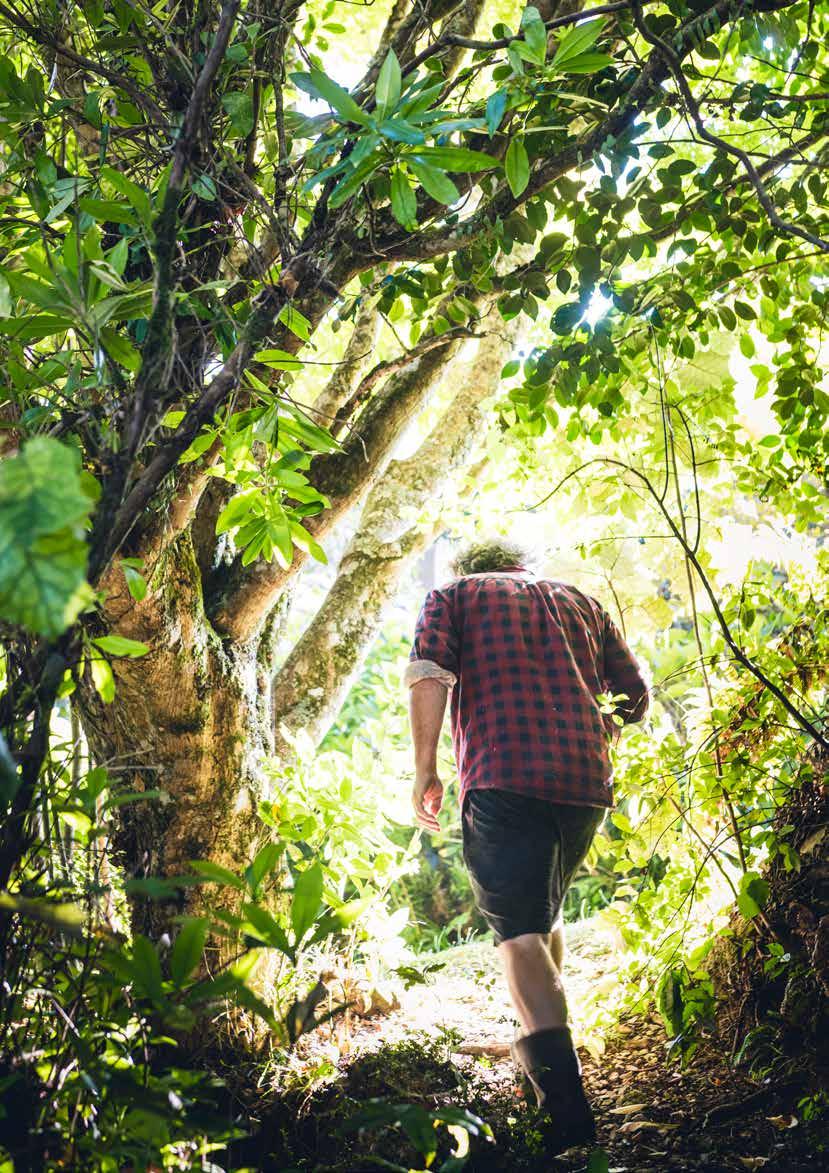
5 QEII NATIONAL TRUST ANNUAL REPORT 2022
| Forever protected
Ngā Kairauhī Papa
Although our annual report is prepared at the same time each year, the time since I prepared my update for the last annual report feels like it has gone by faster than usual.
It has been another year of being agile, with Covid continuing to affect many of us. In most instances, positive cases among the team and in our wider communities caused disruption closer to home than a national lockdown. Through this, we were able to make some changes to the way we go about our day-to-day lives and how we operate as an organisation, including remote working becoming more commonplace for our head office team.
We are hopefully coming through the other side of the pandemic and while it was disruptive, Covid did provide an opportunity for us to kick off additional projects, all funded through the Government’s Jobs for Nature programme. Our four-year work programme for these projects started at the beginning of this year and we have engaged new team members to support them, including a project manager and an administrator.
In the field, we have engaged new reps to fill gaps left by members of our team who decided to hang up their regional representative hats over the past year. We are also looking to increase our overall number of regional representatives and make some changes to region boundaries due to the growth in the number of covenants in each region and new protection enquiries.
I would like to acknowledge the contributions that our outgoing regional representatives, Bill Wallace, Lynette Benson and Rob Fraser have made in their regions and to QEII generally. All three left big shoes to fill, although in Bill’s case, he is still part of the working QEII family, as he has taken on a role managing QEII owned properties, which has been another area of focus for the year.

The biggest property in our portfolio, Remarkables Station, is now in QEII ownership thanks to the generosity and foresight of Dick and Jillian Jardine. Going forward, management of this property will be led by the Remarkables Station National Trust Ltd board, and we welcomed Nita Smith to our team to take on the role of Whakatipu Relationship Manager to assist with the additional work the property will bring to the region. Most of the property will be protected by a covenant and QEII’s intention is to continue operating the property as a working farm, while looking to incorporate open space, environmental and cultural values in the long-term management of the Station.
Sadly, in late-July 2022, we farewelled one of QEII’s great champions with the passing of Dr Brian Molloy. Brian was unofficially known as the ‘godfather’ of QEII National Trust and had a decades-long association with QEII, serving on our board of directors from 1989 to 1998 and then as our high-country representative until his retirement in 2012.
Brian had a great affection for QEII and the landowners who contribute to what we do. On his departure from his high-country rep role, Brian wrote, “the QEII family and its achievements are a standout both nationally and globally and I have benefitted from my time with the family, especially our unique network of inspiring landholders.” His impact at QEII continued well after he retired as he was known for being deeply caring and generous towards his colleagues, sharing his passion for conservation and botany with others.
The financial result for the year a smaller deficit than what was budgeted, which is pleasing. But I am very much aware that the underlying operating position for QEII remains loss-making and unsustainable. We need to address this by adding new revenue streams, such that we can continue to meet demand for our help.
New protection and monitoring visits remain our core work. Over the past year, we have approved 170 new covenants and registered 104, protecting an additional 2,264 hectares and our regional reps have undertaken 1,896 covenant monitoring visits – all impressive numbers when you think about the continued pandemic disruptions and changes to the regional rep team.
An annual report is about numbers and our numbers show that 2021/2022 has been another productive year for the Trust. However, all the numbers, achievements and stories of new protection that you are about to read could not have been done without our regional representatives and head office team. I would like to round off my update with a big thank you to our people for all their work over the past year and to all the landowners who chose to protect their special places with a QEII open space covenant.
Dan Coup CHIEF EXECUTIVE

QEII NATIONAL TRUST ANNUAL REPORT 2022 6 CHIEF EXECUTIVE’S REPORT

QEII NATIONAL TRUST ANNUAL REPORT 2022 7
protected
Ngā Kairauhī Papa |
Forever
Photo credit: Malcolm Rutherford, QEII regional representative for Gisborne
QEII National Trust works in partnership with landowners to protect native biodiversity and other values on their properties, forever. Landowners retain the ownership of the land they are protecting. Our role is to provide the legal protection.

Our mission is to inspire private landowners to protect and enhance open spaces of ecological and cultural significance.
Originally formed by farmers, in 1977 we were established as a registered charity and independent statutory organisation. We are headed by a board of six directors, four appointed by the Minister of Conservation and two elected by QEII members. Our team has grown to include 29 regional representatives, located all over the country and 30 people in our head office, primarily based in Wellington. Our head office team includes legal, ecological advice, health and safety, finance, communications and policy.
QEII NATIONAL TRUST ANNUAL REPORT 2022 8 ABOUT US
Our land, our uniqueness, forever protected, for the future
Tō tātou whenua, tō tātou ahurei, ake ake ake, taonga, hoki te heke mai
WHO WE ARE AND WHAT WE DO
Our annual operating budget is approximately $7.5 million, of which approximately 60% is government-funded through Vote Conservation and administered through a Memorandum of Understanding with the Minister of Conservation. The remainder of our funding comes from Jobs for Nature projects, our investments, memberships, contestable funding, other grants and through the generosity of our members and other passionate private land conservationists.
We partner with landowners to protect a range of ecosystems and other unique features found on privately owned land. We prioritise protection of wetlands, sand dune systems and indigenous lowland ecosystems, as these have suffered the biggest loss. Protecting these ecosystems on private land is vitally important for the future biodiversity of New Zealand.
Partnering to protect land
With 70% of land in New Zealand under private ownership, protecting biodiversity on privately owned land is critical to reversing the decline of indigenous biodiversity. Much of this is in lowland areas where the biodiversity losses have been immense.
Over 4,000 indigenous species in New Zealand are threatened with, or at risk of extinction. Some of our most threatened animal and plant species depend on privately owned land for survival. QEII covenants protect habitat of critically or nationally endangered species including short jawed kōkopu (Galaxias postvectis), short-tailed bat (Mystacina tuberculata), dwarf mistletoe (Korthalsella salicornioides), mingimingi (Muehlenbeckia astonii), and Lyttleton forget-me-not (Myosotis lytteltonensis). Our partnerships with private landowners protect these precious taonga.
Protecting private land with a QEII National Trust covenant is an efficient and effective way to help protect the habitat of threatened animal and plant species.
This year we registered 104 new covenants, protecting 2,264 hectares. We have also approved a further 170 covenants that will protect 3,872 hectares once registered.
QEII NATIONAL TRUST ANNUAL REPORT 2022 9 Ngā Kairauhī Papa | Forever protected Covenanting numbers Total area (approved and registered covenants and formal agreements) 196,310ha 4,991 Total registered covenants
104 New registrations 2,264 ha protected this year 170 approved (3,872 estimated ha) will be protected New proposals
Prioritising protection
There are four National Priorities that we use to guide the prioritisation of covenant proposals. QEII has an understanding with the Minister of Conservation that requires at least 90% of our new protected land to meet one or more of the four National Priorities for Protecting Rare and Threatened Native Biodiversity on Private Land.
QEII approved 170 covenants in the 2021/22 year and 99% of these met one or more of the National Priorities.
National Priorities met by new approvals this year:
National Priority 1: Protects indigenous vegetation in land environments that have 20% or less remaining in indigenous cover. Land Environments New Zealand is a national classification system which is used to map areas of similar habitat. Any land environments that have been reduced to less than 20% of their original extent are prioritised for protection.
National Priority 2: Protects indigenous vegetation associated with sand dunes and wetlands; less than 9% of the original extent of wetlands and less than 11% of natural dunelands remain nationwide, which makes these two ecosystems high priority ecosystems.
National Priority 3: Protects indigenous vegetation associated with ‘originally rare’ terrestrial ecosystem types not already covered by priorities 1 and 2. Originally rare ecosystems are ecosystem types not commonly found in all regions of NZ. There are 72 types falling into six categories which have been identified in NZ–coastal, geothermal, induced by native invertebrates, inland and alpine, subterranean, or semi-subterranean, and wetlands.
National Priority 4: Protects habitats of New Zealand’s most threatened indigenous species of plants and animals. The threat status of threatened native species is determined by specific criteria in the New Zealand Threat Classification System lists created by the Department of Conservation. Covenants approved this year provide habitat for a number of threatened species including some with a nationally critical threat status such as dwarf mistletoe (Korthalsella salicornioide), Lyttleton forget-me-not (Myosotis lytteltonensis), and Australasian bittern (Botaurus poiciloptilus).
Of the 170 proposals approved in the 2021/22 financial year, 78% also added to a protected corridor/landscape by being contiguous with a protected area or by adding value to a landscape where protected areas are sporadic.
In addition to protecting biodiversity values identified by the national priorities, we also protect areas with other special values. Twenty-one covenants approved during 2021/22 also secured the protection of cultural, educational, landscape or recreational values. These special sites are protected with a covenant deed tailored to their unique management needs.
Other factors that we consider when assessing new covenants include looking at how representative the area’s current vegetation assemblages are, compared to a pre-human timeframe. Because unmodified cover is increasingly rare in some regions, secondary communities in these areas are also considered important.
Long-term sustainability is important and is determined by how diverse the proposal area is, how close to other protected areas it is, and the size and shape of the protected area. Large, regular-shaped areas buffered by other native vegetation are more tolerant of external threats such as wind, temperature, humidity, and nutrient fluctuations.
The diversity of habitats and species that live there and the rarity of the type of habitat, plants or animals is also a consideration for assessing a proposed covenant.
At approval, a covenant can be allocated a one-off establishment grant which landowners can use to assist with weed or pest animal control, or revegetation. In 2021/22, QEII allocated $177,000 (excluding GST) of establishment funding to new covenants.
QEII NATIONAL TRUST ANNUAL REPORT 2022 10
ABOUT US
55% 32% 16% 95%
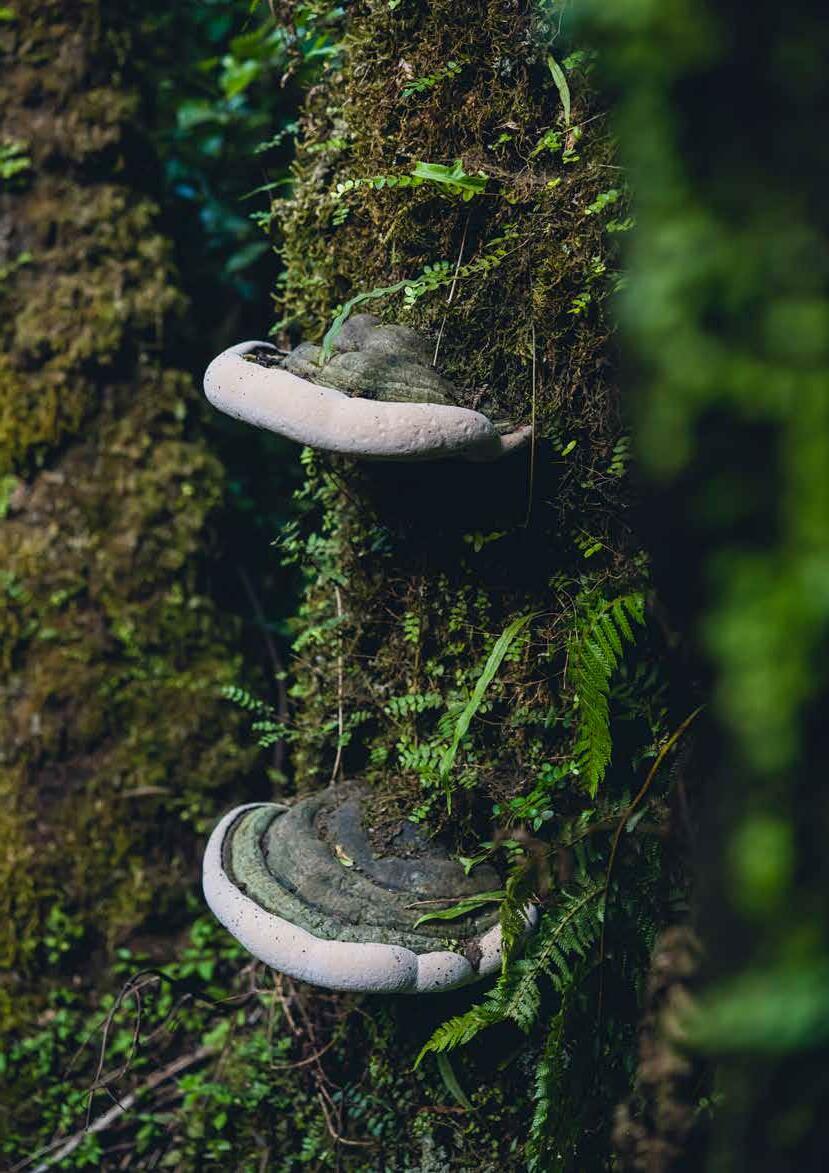
QEII NATIONAL TRUST ANNUAL REPORT 2022 11
protected
Ngā Kairauhī Papa |
Forever
Protecting the land, forever
When land is protected with a QEII covenant, the land remains in the ownership of the landowner and they are responsible for complying with the conditions set out in the covenant agreement. Our regional representatives provide advice to landowners to support their stewardship of their covenant and its open space values.
QEII is the statutory trustee of all registered covenants. As part of this role, we generally monitor covenants every other year to check the condition of the protected values and to raise any threats and management issues with the landowner. This monitoring visit is also an opportunity for our regional representatives to congratulate and encourage the achievements of the landowner and to offer guidance where it is sought or needed.
A small number of monitoring visits find gaps between what is required in the covenant agreement and what is happening on the ground, negatively impacting the values that are protected. In these instances, we work with the landowner to find the best solution.
In 2021/22 we monitored 1,896 covenants and found issues in 219 covenants that required attention. We also resolved issues requiring attention in 58 covenants.
The Stephenson Fund
QEII established The Stephenson Fund in 2017 with the objective of providing support for enhanced covenant stewardship. The fund is named in honour of Gordon and Celia Stephenson, key visionaries in the founding of the Trust, and the first people to register a QEII covenant on their property.
The Stephenson Fund is open to applications from across the country. In addition to enabling projects that will enhance covenants, it is also designed to provide support where hardship is the result of circumstances beyond a landowner’s control.
QEII opened the sixth round of funding on 6 August 2021 which drew 52 applications, 51 of which were eligible and evaluated against the fund’s scoring and assessment criteria. The assessment team comprised of six members of the Land Protection team with regional representatives engaging in the process when there were applications received from their region.
Funding was allocated across 31 projects, including three hardship applications, with grants going towards fencing repairs, revegetation and pest plant and predator control.

QEII NATIONAL TRUST ANNUAL REPORT 2022 12 THE STEPHENSON FUND
covenants monitored this year 1,896 visited covenants require attention 219 58 Summary of monitoring results: 88.5% had no issues requiring attention had an issue which is now resolved
Pest control in the Mahakirau Forest Mahakirau Forest Estate Society received an $8,200 grant through the sixth round of The Stephenson Fund. The grant went towards the society’s ongoing conservation project, supporting an intensive monitoring scheme to inform ongoing predator control operations as part of a wellestablished habitat and biodiversity protection programme.
The project also sought to support innovative trials and endemic species research projects. Notable species include the northern striped gecko, Archey’s frog, forest ringlet butterfly and the Coromandel brown kiwi.
As well as traps for pest control, the Hauraki Coromandel group used the funds to purchase monitoring and surveillance equipment, which has increased their knowledge around enhancing predator control and supported ongoing engagement with the local community. Significant targets were reached with the group’s gecko work, which has been highlighted in a documentary series showcasing community groups working in partnership with Auckland Zoo.
Table 1: Number of projects funded and declined by project type
KEY PROJECT ACTION No. projects funded No. projects declined * Funding approved (excl GST)
Pest plant control 9 6 $71,749 Predator control 7 4 $32,324
Pest plant & predator control 2 1 $22,343 Revegetation 5 3 $34,680 Hardship 3 - $12,609 Other** 5 6 $23,937
TOTAL 31 20 $197,642
* Projects may be declined due to fund limit or not meeting criteria.
** Other: track work and access, signage, historic water source restoration, native plant/listed building protection.
CLOCKWISE FROM TOP LEFT: Goodnature Scientist, Dr Christine Stockum, installing A24 traps and surveillance cameras for a stoat lure trial at Mahakirau
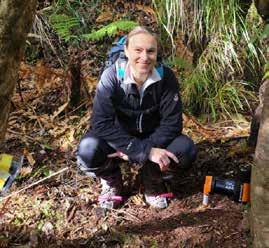


Filming the 'Wild Heroes' documentary, showcasing the Mahakirau Society's research in partnership with Auckland Zoo
A rodent lure comparison trial, utilizing ink card tunnel monitoring
The 100th gecko to enter the northern striped gecko dataset at Mahakirau Forest Estate
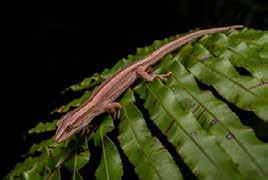
Ngā Kairauhī Papa | Forever protected QEII NATIONAL TRUST ANNUAL REPORT 2022 13
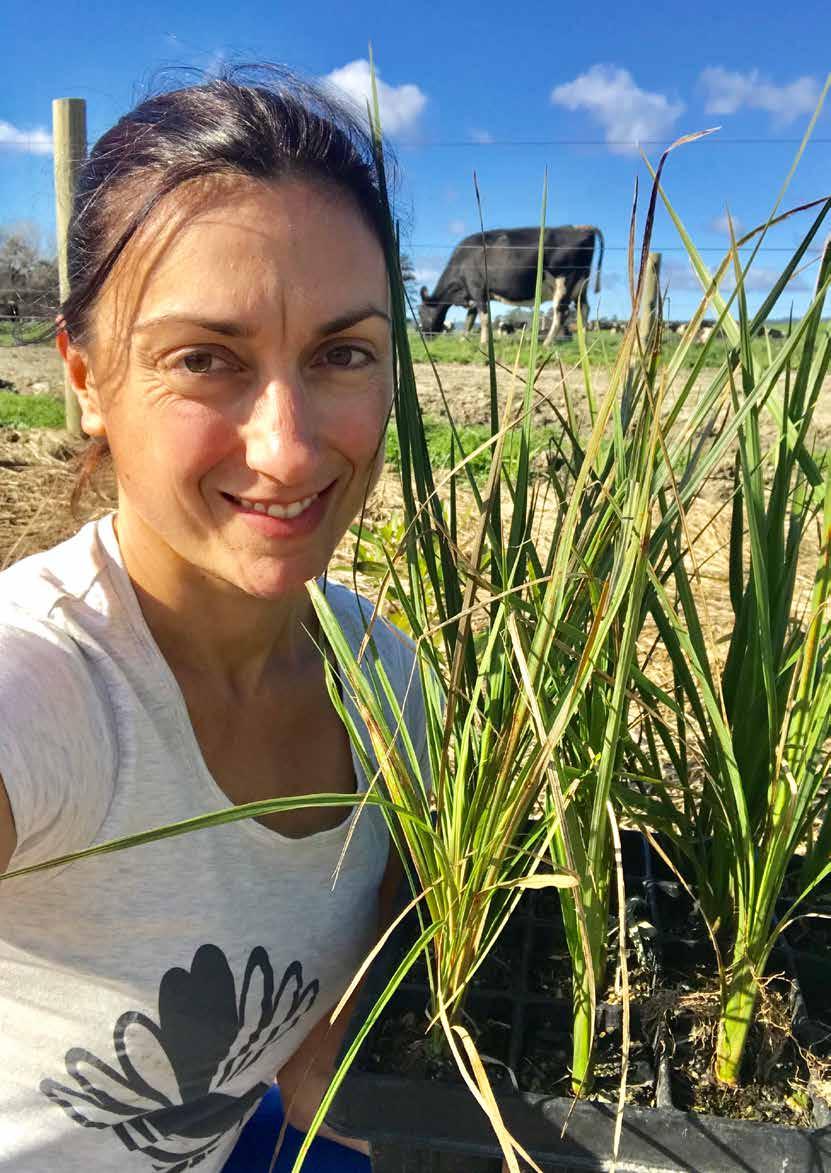
QEII NATIONAL TRUST ANNUAL REPORT 2022 14 WORKING WITH OTHERS
WORKING WITH OTHERS
At QEII we are lucky to be able to work collaboratively with many like-minded groups and individuals who share our goal of protecting and enhancing New Zealand’s landscapes and biodiversity. Our partnerships are wide ranging, with many driven by our regional representatives and their relationships onthe-ground. These partnerships are a great source of support and advice for QEII people, covenantors and team members alike. They also play a crucial role in the protection and enhancement of QEII covenants on private land.
Some of these partnerships are led by volunteers, including the Friends of I’Anson Reserve at QEII property I’Anson Reserve, who regularly host weeding bees and other volunteer activities within the property, and the Forest Bridge Trust who have been maintaining pest traps at Dunn’s Bush, another QEII property.
We have continued to work with many councils and we are thankful for the support we receive from them, including financial contributions towards 87 newly approved covenants in the 2021/22 financial year. Following the May 2020 floods in the Canterbury area, Environment Canterbury also provided $40,000 of funding that enabled us to support covenantors who were adversely affected. The Auckland Council Fund, a contestable fund to support covenant stewardship, was repeated in 2021/22. Sixteen projects were allocated funding for pest plant control, revegetation, predator control, fencing, and other covenant management works.
We entered into a funding agreement with the Ministry for Primary Industries to deliver Kauri protection projects in the upper North Island. This programme of work is part of MPI’s National Pest Management Plan, and the $425,000 funding QEII has received will support approximately 12 projects in the region, supported by our Northern regional representatives.
We have also received funding through the Lotteries Commission for two projects.
The Cape Turnagain project was a two-year project that was extended for a further two years due to Covid. The Kōkako relocation project enabled us to translocate three pairs of kōkako from Kaharoa in one breeding season and three pairs of kōkako from Rotoehu in another breeding season to bring genetic diversity to the kōkako population in the Manawahē forest, an area protected, in part, by QEII covenants.
This project saw some success with new kōkako pairings established, along with a successful nesting attempt. It enabled us to make a positive contribution towards the recovery of kōkako and helped raise the threat status of kōkako from threatened, to near threatened, due to predator control and reintroductions. This success was also thanks to our partners, Manawahē Kōkako Trust, Manawahē Eco Trust, Kaharoa Kōkako Trust, Rotoehu Ecological Trust, Ngāti Rangiwewehi, Tapuika, Ngāti Makino, Ngāti Rangitihi and Ngāti Awa.
QEII also continues to be active in the academic space, with a key focus on supporting universities and research organisations to promote science that will benefit conservation on private land. This includes the QEII Athol Patterson Bursary, which helps support a student at Massey University who demonstrates a commitment to environmental studies and sustainable farming practices.
This year we selected Jo Wood for the QEII Athol Patterson Bursary. Jo is studying towards a Bachelor of Science at Massey, majoring in Environmental Studies. She lives in a small rural community at Tomarata where she works on her brother’s dairy farm, undertaking pest control in the areas of covenanted native bush on the property.
In response to receiving the scholarship, Jo said, “thank you so much for this opportunity to concentrate on my studies instead of working all-hours to pay the bills. Third year studies are certainly time consuming. It's a privilege to be able to live and study here, and hopefully what I learn will be of benefit to something, somewhere in Aotearoa in years to come.”
QEII NATIONAL TRUST ANNUAL REPORT 2022 15 Ngā Kairauhī Papa | Forever protected
LEFT: Jo Wood, QEII Athol Patterson Bursary recipient
OUR SUPPORTERS
Thank you
We are grateful to all the generous individuals, groups and organisations that support QEII, both as financial members and donors. We are also extremely thankful for the dedicated support we receive through the Partners in Protection Ōhākī gifts in will programme, which assists us in our work to protect and enhance QEII covenants on private land in perpetuity.
Notably for our 2021/22 financial year, we would like to thank the estates of Margaret (Bunny) and John Mortimer, the Irvine Estate, and the Perrin Estate, and our donors Sir Stephen and Lady Margaret Tindall, Mrs F Campbell, the Basil & Cynthia Hewett Charitable Trust, Brendon the Vegan, John and Elisa Mendzela, Pru Robbie, Catherine Smith, Sue Chapman, Tui Aroha Williams, Dr Ralph Samuelson and our generous anonymous donors.
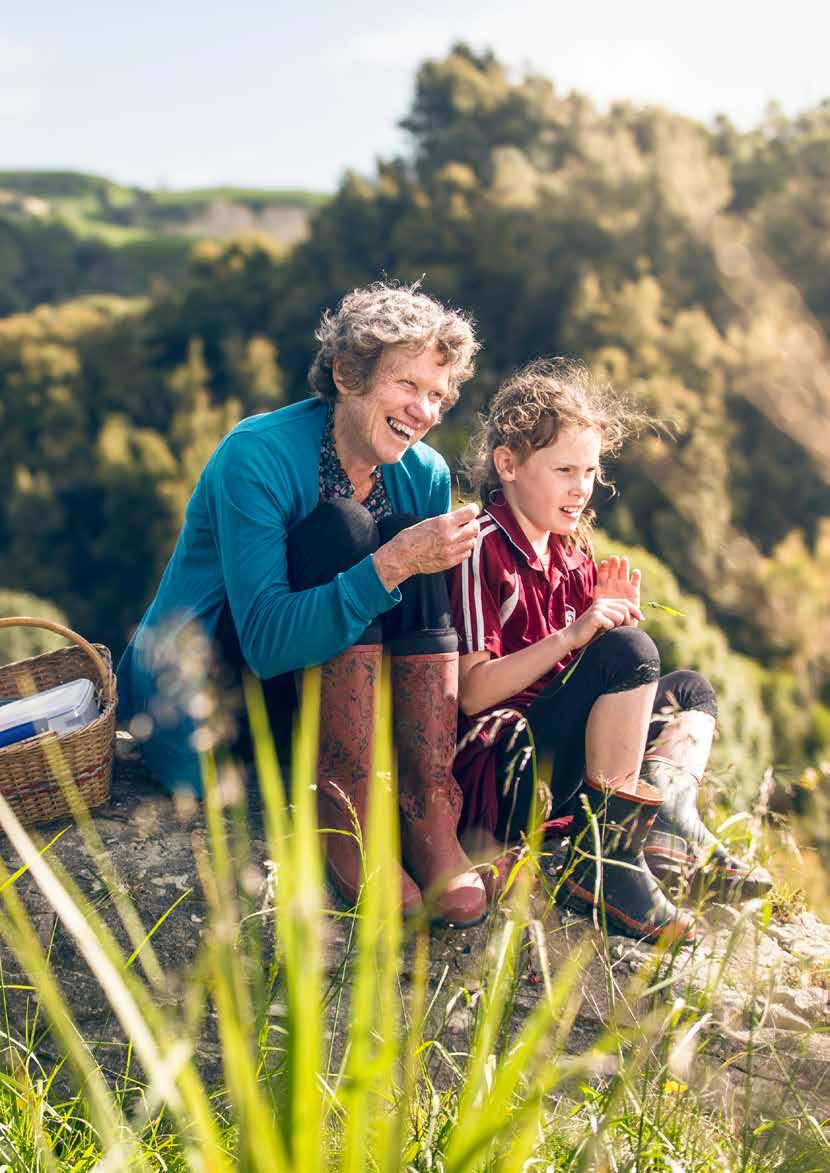
QEII NATIONAL TRUST ANNUAL REPORT 2022 16 OUR SUPPORTERS
Partners in Protection Ōhākī
In September 2021, we were thrilled to announce the launch of our Partners in Protection Ōhākī gifts in will programme; a way that you can support our crucial work by leaving a gift in your will.
The QEII National Trust Partners in Protection Ōhākī programme honours the generosity of individuals and families who plan to leave us a gift in their will.


QEII has proven its expertise time and again in the last 40 years, protecting and enhancing hundreds of thousands of hectares of open space. Making a financial contribution to support QEII’s work is one of the best ways to help preserve Aotearoa New Zealand’s natural and cultural heritage. Every dollar we receive helps grow the network of private land protected in New Zealand, in perpetuity.
"Kaitiakitanga is a team effort," QEII Chair Bruce Wills says. "Landowners are already leaving a legacy by protecting their land with QEII, and we are now focused on strengthening this commitment through our Partners in Protection programme.
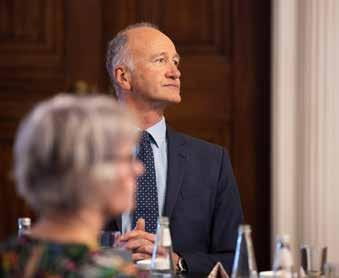
“We’ve got a proven recipe, and as a covenantor, I’ve experienced first-hand the incredible support landowners get from QEII – and the sense of pride and enjoyment in knowing my land is protected in perpetuity.”
“We’ve reached a stage where we need to take control of our destiny and have certainty of our own existence, so that we can help to ensure our special places of ecological and cultural significance remain for future generations.”
We are incredibly thankful to all our supporters who have already included QEII in their will. For more information, see qeii.org.nz/partners-in-protection
Mr Bruce Wills ONZM, Chair of the QEII Board of
QEII NATIONAL TRUST ANNUAL REPORT 2022 17 Ngā Kairauhī Papa | Forever protected
ABOVE
Partners in Protection Ōhākī was officially launched on Tuesday 21 September, hosted by our Vice-Regal Patron, Her Excellency the Rt Hon Dame Patsy Reddy Governor-General of New Zealand, in Her Excellency’s final event in that role and attended by the Minister of Conservation at the time, Hon Kiri Allan, and some of our network of supporters and stakeholders
“ The time to leave a lasting legacy is now”
Directors
UPHOLDING OUR PROTECTION

QEII NATIONAL TRUST ANNUAL REPORT 2022 18 UPHOLDING OUR PROTECTION
Upholding covenants on behalf of landowners and advocating for issues that impact the work that we do continue to be an area of focus for QEII.
In the last financial year, we have continued to engage in advocacy and legal processes, ensuring that QEII remains the gold-standard for robust protection of indigenous biodiversity on private land in Aotearoa.
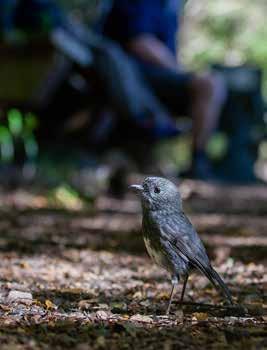
Partnerships are central to our work, however, where covenant values are under threat, we champion the protection of QEII covenants and the properties we own through participation in legal processes like litigation and involvement in RMA submissions and hearings.
We also have a mandate under our Act to advocate for and advise on the protection, preservation, use and enhancement of open space values in Aotearoa New Zealand. In the last couple of years, QEII has seen an increase in this advocacy work, more regularly making submissions on legislative changes and engaging in policy development processes across central and local government.
While the focus for engaging in these processes is championing QEII protection, it is also a way for us to collaborate with others, advocate for the landowners with whom we partner, and build stakeholder relationships and awareness of QEII’s work across different sectors and levels of government.
Examples of work undertaken in the past year
• Whangārei airport proposal
In May 2022, Whangārei District Council carried out public consultation on options for a new airport site for Whangārei. One of the sites overlapped with a covenant containing exceptionally high biodiversity values, and others in the area were at risk. QEII had serious concerns about the impacts that the proposed airport would have on these covenants.
We made a submission focusing on the significant risk to high value biodiversity that the proposed site posed. We set out that the forest remnants in the covenants were irreplaceable, meaning the impacts of an airport development were incapable of being addressed through any offsetting or mitigation, and so the site in question could not be considered a viable location for the airport. Nan Pullman, regional rep for Whangārei, spoke to Councillors about our submission at a hearing, driving home the significance of the sites and QEII’s commitment to protect them forever.
In August 2022, the Council confirmed that they had selected a different site that would not affect any QEII covenants.
Submission on proposed changes to the Emissions Trading Scheme (ETS) ‘Managing exotic afforestation incentives’
In April 2022, the government consulted on the proposed removal of exotic forests from the new permanent post-1989 forest category in the ETS. This was in response to concerns from multiple sectors that the ETS was driving more land-use change to exotic forestry than originally intended, leading to unintended perverse outcomes. The government also sought feedback on how to reduce barriers and incentivise indigenous afforestation for carbon sequestration.
These issues are relevant to QEII for a couple of reasons –large scale conversion to exotic forestry has recently been largely driven by the ETS, and our regional reps are increasingly observing the negative impacts of this land-use change on protected covenant values. While we recognise that this is a very complex issue with a range of policy changes required, we supported the proposed change and used our submission as an opportunity to share our concerns regarding exotic forestry impact on biodiversity and covenant values.
We strongly support improved incentives for native afforestation and emphasised in our submission that we would like to see improved recognition of the carbon sequestration that is occurring through natural regeneration of native forest, including in QEII covenants. While we know that most QEII covenants are to some degree sequestering carbon, it is currently very difficult for landowners to receive any financial recognition of this. Improving recognition and incentivising native afforestation will both recognise the good work QEII covenantors and others are already doing and facilitate this work at a greater scale.
We’re awaiting a final decision from the government on the ETS proposal and will continue to advocate for improved recognition and incentives for native regeneration/afforestation for carbon sequestration and biodiversity co-benefits.
QEII NATIONAL TRUST ANNUAL REPORT 2022 19 Ngā Kairauhī Papa | Forever protected
North Island Robin Photo credit: Malcolm Rutherford
EXAMPLES OF NEW PROTECTION
Avoca Valley
In 2018 the Summit Road Society purchased Tussock Hill Farm, near Christchurch, which was made possible thanks to generous bequests and donations. Renamed Linda Woods Reserve, the 233 hectare farm has been partially covenanted and is being transformed for the benefit of public enjoyment and the environment.

The Summit Road Society has been working tirelessly to protect the Port Hills and provide public access since 1948 and the purchase of the Linda Woods Reserve provides one of the last puzzle pieces in a corridor of reserves across the Port Hills for all to enjoy.
The Summit Road Society has worked in partnership with QEII for three decades and has eight open space covenants. The Summit Road Society wanted to protect 126 hectares of Linda Woods Reserve, over half of the farm, with a covenant to ensure legal protection of the site and secure all their efforts to revegetate the area.
Once a key route for Ngāti Wheke on their journey from Rāpaki to Ihutai (the estuary) and an important source of mahinga kai (food gathering), Avoca Stream now runs dry for much of the year. The local community has been involved since the 90s and they are now carrying out considerable recloaking/planting of the stream to restore and protect its mauri for future generations to experience as past generations once did.
Funding from the Department of Conservation’s Jobs for Nature – Mahi mō te Taiao project allowed the Summit Road Society to fast track the large-scale restoration project in Avoca Valley. In the past year, they have put over 39,000 eco-sourced plants in the ground and it was important to Marie Grey, secretary of the Summit Road Society, that the covenant protected both the plantings and the existing native grassland, shrublands, rock outcrops and public access tracks. The project also received support from Wai-Ora, Ngāti Wheke, the Avoca Valley community, Christchurch City Council, and generous donations from members of the public, businesses, and Environment Canterbury.
QEII NATIONAL TRUST ANNUAL REPORT 2022 20 NEW COVENANTS
The involvement of volunteers and community members is essential for the restoration of the valley. Carrying out the restoration at landscape scale has provided better outcomes for joint predator control and planting, with volunteer planting days helping to build momentum and buy-in from the wider community. Marie says that the best part of having volunteers involved in the project is seeing people get excited about what could happen. Repeat volunteers come out and see the change that they are making and get excited when they see the wildlife return. Following these restoration actions, people are starting to see pūkeko and kōtare more frequently, along with more invertebrates. The valley is starting to buzz with life.


This covenant is all about the landscape, with expansive views across city and plains. What little is left of the original vegetation cover is an inspiration for the massive revegetation effort. Pockets of trees, shrubs and special rocky outcrop plants on the volcanic cliffs are reminders of what has thrived in this valley. Meeting National Priority 2, this site contains spring and seepage areas that support
wetland species. The area also meets National Priority 3, containing volcanic rock outcrops and boulderfields that are naturally uncommon and vulnerable ecosystems, supporting species such as prostrate kōwhai.
The site also meets National Priority 4 by protecting several Threatened and At-Risk species, including grassland speargrass, matagouri, rauhuia, Banks Peninsula sun hebe, Banks Peninsula hebe, Banks Peninsula button daisy and Juncus distegus. The covenant adds to a corridor of protected land on the Port Hills as it is contiguous with Duncan Park and Witch Hill Reserve. The area is enjoyed by thousands of people each year as it can be publicly accessed and viewed from the Port Hills Trust Board-Mt Vernon Park (Rāpaki Track).
TOP FROM LEFT: Early planting in Avoca Valley
QEII NATIONAL TRUST ANNUAL REPORT 2022 21 Ngā Kairauhī Papa | Forever protected
LEFT: Matthew helping with planting. Photo credit: Marie Grey
Peat Wetland
The Peat family have owned Mangapapa Station in the Waitōtara Valley for around 130 years. Located in South Taranaki, the station is a 3,500 hectare sheep and beef farm with 1,400 hectares of primary and regenerating bush and 30 hectares of wetlands.
David and Karen Peat are leaders in the district and a great example of landowners who manage their station sustainably, while obtaining good returns from the land. Their work tackling soil erosion saw them win a Taranaki Environmental Award in 2019, recognising their outstanding initiative to protect and enhance the region's high-quality environment.
Last year, David and Karen added to the protected landscape on their property by registering their fourth covenant, bringing their protected areas up to a total of six wetland lakes, plus their wetland margins.
The new covenant protects 1.86 hectares of lowland secondary reedland and open water, meeting National Priority 2 by protecting vegetation associated with wetlands and National Priority 4 by protecting habitat used by endangered species. The area is dominated by raupō, Carex and the aquatic native plant Azolla rubra. Mānuka (At Risk - declining) and sphagnum moss (At Risk – Naturally Uncommon) are also present.
Taranaki Regional Council contributed a third of the fencing cost, with QEII and the landowners also paying a third each. Taranaki Regional Council also contributed $3,000 towards revegetating the margins of the wetlands to enhance the diversity of this area.
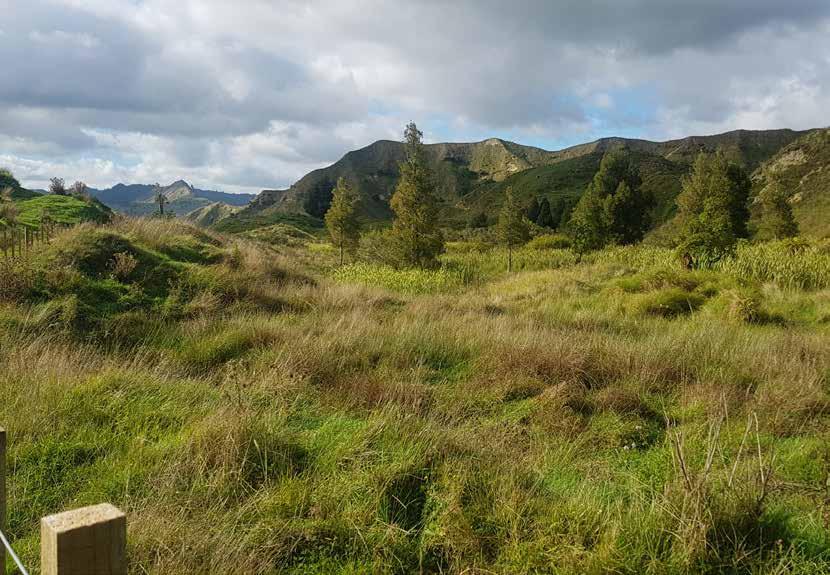
QEII NATIONAL TRUST ANNUAL REPORT 2022 22 NEW COVENANTS
All six of the protected lakes on the farm are part of a wider complex of over 50 lakes and wetlands known as the Puketoro or Makakaho Ponds, which are recognised as significant habitats by both the Regional and District Councils. Wetlands in Taranaki are underrepresented and are considered At-Risk by the LENZ Threatened Environment Classification.
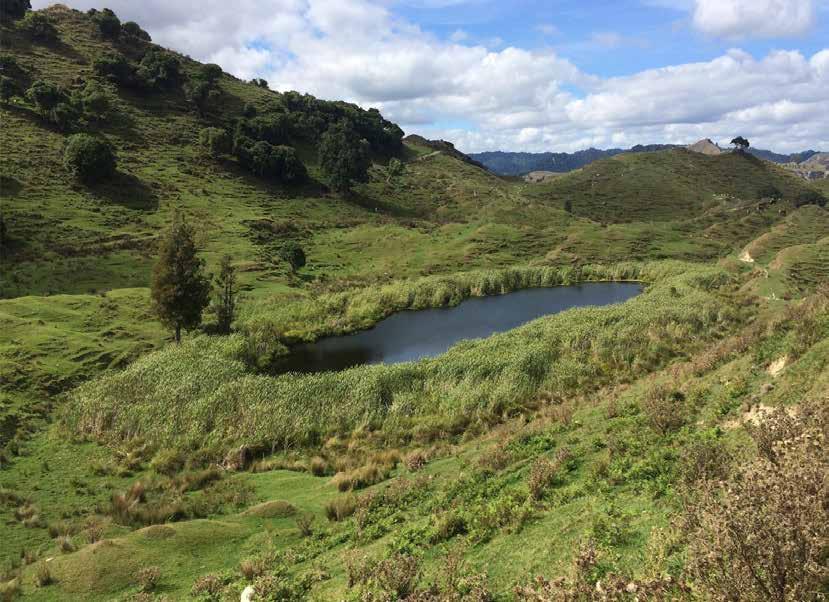
The wetland lakes provide important habitat for Nationally Threatened and At Risk indigenous species such as pūweto (spotless crake), dabchick, North Island fernbird and grey duck. All six protected wetland lakes, totalling 15.4 hectares, have been fenced off, protecting the lakes, water quality and the swampy vegetation that surrounds them and allowing the wetlands to thrive.
Along with the formal protection and fencing of the wetland lakes, David and Karen have planted 10,000 native plants around the wetlands and are undertaking predator control to benefit the Threatened and At Risk wildlife found in the area. David and Karen have also noticed that the birdlife has increased significantly, with trees and plants thriving and shooting up quickly.
LEFT: Deep beds of sphagnum moss in mānuka on the wetland edge
TOP LEFT: A view over one of the protected wetland areas on the station
BOTTOM RIGHT: Looking east over wetland lake

QEII NATIONAL TRUST ANNUAL REPORT 2022 23 Ngā Kairauhī Papa | Forever protected
JOBS FOR NATURE
QEII was pleased to secure funding from DOC’s Jobs for Nature (JFN) programme to support projects on private land.
Protecting the Gains
QEII has secured an additional $8 million of funding over four years (2021 – 2025) for a project called ‘Protecting the Gains’. This funding is enabling us to work with landowners to secure enduring outcomes on private land where some of the $1.3 billion government investment in the Jobs for Nature programme is being made.
The extra funding is enabling us to increase the number of sites protected by approximately 250 over the fouryear project. We are working with recipients of Jobs for Nature funding on private land to offer two forms of legal protection, our standard Open Space Covenant or a Restoration Agreement – a new legal protection tool that has been developed as part of this project. Restoration Agreements will enable QEII to protect Jobs for Nature investment on private land where biodiversity values at the site do not yet meet the criteria for protection in perpetuity by an Open Space Covenant.
So far through this project, we’ve worked with 22 landowners, protecting 28 sites and 1,260 hectares of private land that has received JFN funding.
An example of an Open Space Covenant funded by this additional Jobs for Nature funding is highlighted on page 20.

QEII NATIONAL TRUST ANNUAL REPORT 2022 24 JOBS FOR NATURE
Jobs for Nature project –covenant type Approved Ha (approximate) Registered Ha Open space covenant 28
5 695
1,264
were
Restoration
approved
financial year.
Note: There
no
Agreements
in the 2021/22
DOC Private Land Biodiversity Fund
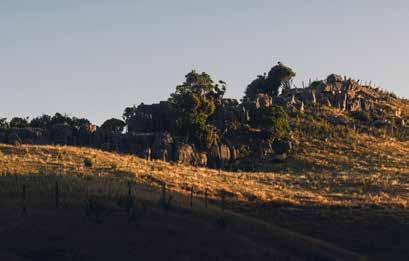
We have also initiated two further Jobs for Nature projects, funded through DOC’s Private Land Biodiversity Fund. These will support landowners with existing QEII covenants and give us an opportunity to support landowners with work that isn’t possible with our usual funding.
QEII covenant deer exclusion project (NZ wide)
Funding of $2 million over 3 years ($1m North Island, $1m South Island) will be put towards this project to exclude pest deer from existing QEII covenants where deer exclusion has been identified as the highest conservation priority. The project will engage fencing and ungulateculling contractors to exclude pest deer and upgrade conventional fencing to deer-proof status in participating covenants.
A project administrator has been engaged to facilitate site selection, contractor engagement and invoice payments. Our regional representatives have been identifying priority areas and work on the ground will begin later in 2022.
Accelerating stewardship of rare and threatened species (Eastern South Island)
This project will work over 3 years with selected covenants in the Eastern South Island that support and protect some of Aotearoa’s most rare and threatened indigenous biodiversity. The project will involve a combination of ecological surveys and planning, as well as a range of site-specific on-the-ground conservation actions.
A project manager was contracted in late-21/22 to work with QEII regional representatives to identify and finalise sites to be included in the project. Because of the nature of these species, much of this work will be seasonal (undertaken in spring and summer), and work will commence on the ground in spring 2022.
QEII NATIONAL TRUST ANNUAL REPORT 2022 25 Ngā Kairauhī Papa | Forever protected
REMARKABLES STATION
A significant amount of work this year went into ensuring QEII was well set-up to receive and manage the extraordinary gift of 947 hectares of land, known as Remarkables Station, from the Jardine family. The gift was officially transferred to QEII National Trust on 1 July 2022.
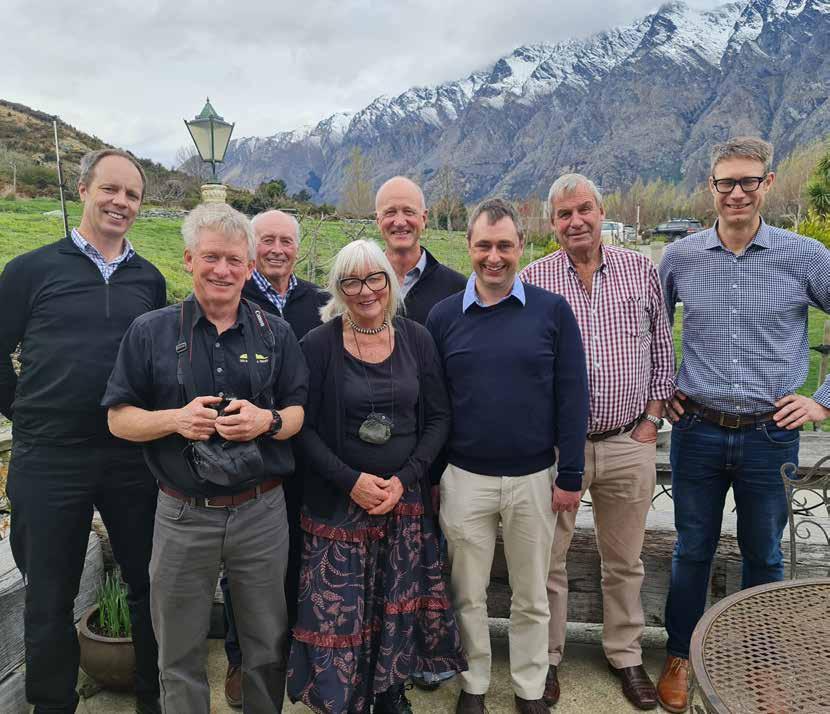
The Jardine Family, who owned and farmed the property for 100 years, announced their intention to gift the property to QEII in 2020 and much of the 2021/22 year has been focused on developing a vision for the property and laying a foundation for its ongoing governance and management.
QEII has consulted with the local community to help guide and identify their goals and develop a vision for the property. The hydrological and ecological values of the property were assessed and a review of the existing farm enterprise undertaken. We engaged Aukaha to provide a preliminary cultural. values statement, and a full financial assessment was conducted.
As a result, we have developed a 50-year strategic plan, which sets out the vision, goals, opportunities and constraints for the property along with a strategic action plan for how to deliver the goals over the short, medium and long term.
QEII NATIONAL TRUST ANNUAL REPORT 2022 26 REMARKABLES STATION
Remarkables Station National Trust Limited (RSNTL) was established to operate as a wholly owned subsidiary, with a separate board of directors appointed to oversee the running of the property and reporting back to QEII. The current board members are Donna Field (Chair), Bruce Wills, Neil Cullen, Alan Livingston, Edward Ellison and James Guild.

We welcomed Nita Smith to the QEII team in the new role of Whakatipu Relationship Manager. Nita’s role is to manage the on-the-ground aspects of the property and work alongside QEII’s regional representative Rob Wardle on aspects related to the nearby Mahu Whenua covenants.
The previous lessees, David and Pam Nind and Matt Little, have signed up to continue to lease the farm operation which will give continuity to the block through their on-theground knowledge of the farm.
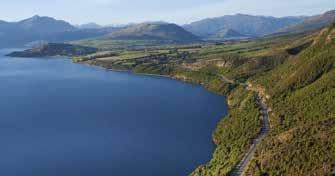
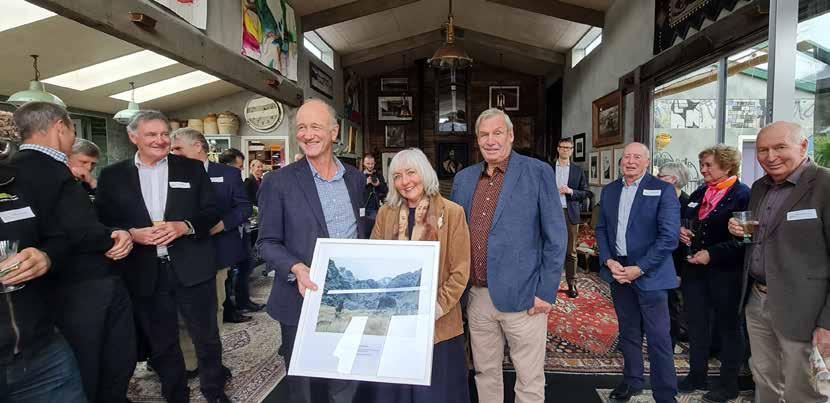
Our plans for the next financial year include delivering on strategic planning and continuing to build relationships. We will be looking to host an in-person board meeting on site and taking the opportunity to host a hui with the seven local runaka, which we hope will help us to form a strong and lasting relationship with mana whenua.
On an operational level, we plan to control sycamores, work with regional predator control groups, and assess the carbon potential in the retired and regenerating portion of the property. We are looking forward to the future for this property and the exciting conservation and recreation collaborations that are sure to arise.
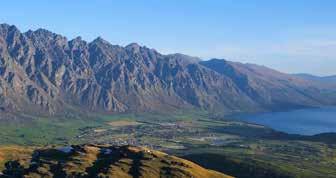
Ngā Kairauhī Papa | Forever protected QEII NATIONAL TRUST ANNUAL REPORT 2022 27
LEFT:
QEII CE Dan Coup, Central Otago regional rep Rob Wardle, former QEII Chair James Guild and current Chair Bruce Wills, with the Jardines and their advisers, Phil Stevenson and Sam Nelson
BELOW: Aerial shots of Remarkables Station
Bruce Wills presenting Jillian and Dick Jardine with a framed photo taken on Remarkables Station at the event marking the transfer of the property from the Jardine family to QEII ownership.
ABOVE:
The QEII team, made up of regional representatives, head office staff and board of directors at Pāuatahanui Inlet

Our people
In the last few years, the number of people in the QEII team has grown. As of the end of June 2022, we have 30 staff in our head office team. This increase includes new team members to assist us with the delivery of the projects we are undertaking as part of the government’s Jobs for Nature (JFN) programme, as well as to support our business-asusual functions.
In the field, we have 29 regional representatives contracted to QEII, along with three monitoring assistants. Our regional representative team grew from 27 last year. This increase again reflects resourcing required to deliver in the JFN space, as well as servicing the growing number of registered QEII covenants and the work required to monitor these.
While regional representatives and monitoring assistants are not employees, QEII works to ensure that they are engaged with our team at head office and employees and regional representatives work closely together.
As an employer in New Zealand, we are obliged to meet the good employer requirements of the State Sector Act. In addition to this, we value our people. They are key to ensuring that we get the best outcomes possible for the protection of open space values on private land throughout New Zealand.
QEII NATIONAL TRUST ANNUAL REPORT 2022 28 OUR PEOPLE
QEII NATIONAL TRUST ANNUAL REPORT 2022 29 Ngā Kairauhī Papa | Forever protected
QEII staff and regional representative statistics Gender Female 48% Male 52% Non-binary 0%
not to say 0% Other 0% 20–29 3 30–39 11 40–49 11 50–59 12 60–69 11 Prefer not to say 1 Age Reps 49% HQ 51% Staff and regional representatives Other 4 Pasifika 0
not to say 0 NZ European or Pākehā 37 Asian 1 Māori 1 European 6 Ethnicity
20 plus years 15–20 years 10–15 years 5–10 years 2–5 years 1–2 years 1 year or less
Prefer
Prefer
Length of service for all QEII people Reps Staff
Our commitment to being a good employer:
Wellbeing: All employees have access to employee assistance programmes and are eligible for an annual health and wellbeing allowance. This allowance encourages healthier living by contributing financially to wellness-related activities or items for employees. Our staff-led health and wellbeing committee remains active in hosting wellness activities for head office staff, with a variety of activities that focus on both physical and mental health.
Flexible working: Flexibility in the workplace has continued to be a focus for us. During the last lockdown, we supported our team back into the work from home model. As we moved through the covid traffic light levels, those who wanted time in the office had the option to do so safely and we implemented a bubble system among the team. Following the lockdowns, many of our team continue to have flexible working arrangements, with working from home options available and we also have some team members who are based outside of our head office location.
Health and safety: Like most businesses, our Covid-19 response has been guided through utilising health and safety risk assessments. Through this, we weathered the storm and developed new ways of working and interacting with our covenantors while managing Covid-19 as a risk to our people. We have continued to provide a safe and healthy working environment for our people and continue to review our Health and Safety Management System (HSMS). This year we have developed a road map of actions to make our HSMS more accessible, relevant and modern. This builds on our current systems and contributes to our ongoing positive safety culture.
Growing with our people: Over the last year, we undertook renovations to improve our office space to accommodate our new head count and create fit for purpose spaces for our work. We took on additional office space in the same building to create a set of meeting rooms and moved to an open plan office to ensure all team members can sit and work together.
Dog days: We pride ourselves on being a dog friendly workplace and continue to have four-pawed visitors to our head office on a regular basis. Anecdotally, staff morale and general wellbeing in the office is lifted on dog days and our furry teammates have become part of the QEII whānau.



ABOVE: Dog days with Gemma, Cleo, Twiggy and Loki

QEII NATIONAL TRUST ANNUAL REPORT 2022 30 OUR PEOPLE
Covenant statistics
Regional Council Total region area (ha)
Total approved covenants not yet registered
Total number of registered and formalised*
Total number of approved, registered, and formalised
Total area of approved, registered, and formalised (ha)**
Total area of registered and formalised (ha)
Largest registered covenant (ha)
Average registered covenant area (ha)
Median registered covenant area (ha)
Auckland 494,162 7 298 305 3,993.7 3,970.8 840.8 12.8 3.0
Bay of Plenty 1,207,050 6 187 193 9,315.6 9,299.3 6,563.5 50.5 4.0
Canterbury 4,450,760 59 382 441 20,219.4 15,342.7 1,679.4 41.2 8.1
Gisborne 838,582 17 144 161 5,355.0 5,084.4 1,103.8 35.5 9.1
Hawke's Bay 1,413,721 15 266 281 11,821.2 10,952.3 4,606.0 41.3 10.1
ManawatūWhanganui 2,222,059 49 409 458 9,834.7 8,538.3 352.3 20.9 7.4
Marlborough 1,045,765 8 95 103 5,450.3 4,969.5 1,055.7 51.0 8.1
Nelson 42,441 1 18 19 323.1 319.6 139.5 17.8 5.9
Northland 1,250,032 23 770 793 11,189.1 10,650.1 420.6 13.8 3.6
Otago 3,120,863 21 224 245 66,420.2 64,869.4 21,909.6 292.2 7.7
Southland 3,119,495 23 387 410 10,549.7 9,593.7 1,456.6 24.9 8.9
Taranaki 725,436 55 477 532 10,620.9 9,932.5 915.5 20.9 2.8
Tasman 961,623 4 189 193 3,305.0 3,221.6 399.9 17.1 3.8
Waikato 2,389,990 44 702 746 18,592.8 17,261.1 801.6 24.2 6.3 Wellington 804,866 18 370 388 6,688.4 6,359.6 824.3 17.0 4.6 West Coast 2,324,381 12 106 118 2,630.7 2,350.9 233.0 22.2 7.7 All Regions 362 5,023 5,385 196,309.8 182,715.7 21,909.6 36.4 5.4
Protected open space Number Area (ha) Registered covenants 4,991 181,790.8 Approved covenants** 362 13,594.1 Formal agreements* 32 925.0 TOTAL** 5,385 196,309.8
QEII National Trust Registered Covenants Number of covenants
1982
* Formalised covenants include landscape protection agreements with a territorial authority (e.g., district council) over land that has no legal title, as well as 14 QEII National Trust properties with no registered covenant established prior to the Trust’s ownership.
ha Area (ha) average registered covenant area
QEII NATIONAL TRUST ANNUAL REPORT 2022 31 Ngā Kairauhī Papa | Forever protected
** Areas are approximate as not all approved covenants have been formally surveyed. Total number of registered covenants Total area of registered covenants (ha) 36.4
5,000 4,500 4,000 3,500 3,000 2,500 2,000 1,500 1,000 500 0 1979
200,000 180,000 160,000 140,000 120,000 100,000 80,000 60,000 40,000 20,000 0 1984 1986 1988 1990 1992 1994 1996 1998 2000 2002 2004 2006 2008 2010 2012 2014 2016 2018 2020 2022
QEII National Trust covenants and Manaaki Whenua Threatened Environments Classification (2012)
95% of registered covenants are
100 ha or less
QEII National Trust-owned properties:
• 26 properties (1,433 ha)
(14 formalised & 12 registered as covenants).
• 1 license to occupy (85 ha)
Organisations with the most covenants: Pāmu (Landcorp Farming Ltd)
• 227 registered covenants (9,859 ha)
Public Conservation Land Crown Copyright: Department of Conservation Te Papa Atawhai [2022] Threatened Environments Classification 2012 created by Manaaki Whenua (Landcare Research) and licensed for re-use under Creative Commons Attribution 3.0 NZ
Canterbury: region with largest area of new covenants registered in 2021/22
979 ha
Southland: region with the largest proportion of covenant area classed as wetland
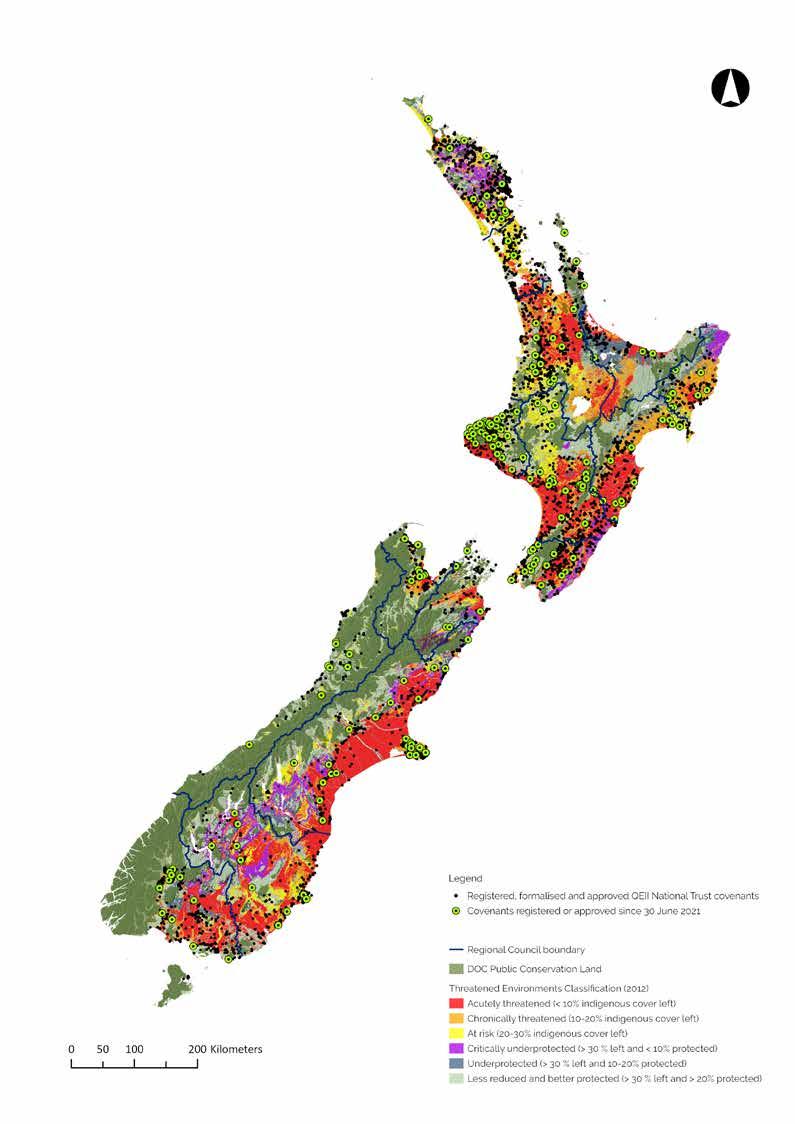
21%
Taranaki: region with the largest number of new covenants registered (and proposals approved) in 2021/22 24 (33)
Northland: region with the largest number of registered covenants
770
Gisborne: region with the highest % of covenanted land classed as acutely or chronically threatened
50%
Canterbury: region with the greatest area of land covenanted in 2021-22 classed as acutely or chronically threatened 252 ha
Canterbury: region with the greatest area of covenanted land classed as acutely or chronically threatened
4,546 ha
Legend
Registered and approved QEII National Trust covenants
Covenants registered or approved since 30 June 2021 (dots represent locations only and not actual area of covenanted land)
Regional Council boundary
Otago: region with the greatest area of registered covenants
64,869 ha
DOC Public Conservation Land
Threatened Environments Classification (2012)
Acutely threatened (<10% indigenous cover left)
Chronically threatened (10-20% indigenous cover left)
At risk (20-30% indigenous cover left)
Critically underprotected (>30% left and <10% protected)
Underprotected (>30% left and 10-20% protected)
Less reduced and better protected (>30% left and >20% protected)
COVENANT INFORMATION
Statement of Service Performance
2019/20 Actual 2020/21 Actual 2021/22 Actual
Number Area (ha) Number Area (ha) Number Area (ha)
Approved covenants 120 3,276.7 134 2,944.8 170 3,871.9 Registered covenants 110 2,257.9 128 1,830.2 104 2,263.9
Other activities
Percentage of all new covenants approved that secure protection of one or more of the four national priorities for biodiversity protection on private land and/or add to a protected corridor or protected landscape
Provision of advice to new owners following change of covenant ownership in regards covenant values and stewardship and legal responsibilities for covenant management. (Percentage of all change of ownerships)
Landcover type
All registered covenants
Wetland 5%
Exotic cover 5% Scrubland 8%
2019/20 Actual 2021/22 Actual 2021/22 Actual
100% 100% 100%
388 (100%)
446 (100%)
412 (100%)
Other types 10% Grassland/ tussockland 27%
Vegetation types are grouped into six categories.
93% of covenanted grassland/tussockland (approximately 43,500 ha) is located in the 17 largest covenants, each over 1,000 ha in size.
81% of covenanted forest (approximately 68,000 ha) is located in covenants < 1,000 ha in size.
Wetland 3%
Forest 48%
Covenants Registered in 2021/2022 Grassland/ tussockland 1%
Exotic cover 34% Other types 7%
Forest 45% Scrubland 7%
102 of the 104 covenants registered in 2021/22 were < 250 ha. Forest was the most frequently recorded vegetation type (approx. 1,090 ha). 34% of covenants registered this year had some exotic cover within the protected area. This included areas of retired pasture grass within covenants that were registered to protect landscape features. It also includes areas of gorse, functioning as a nurse crop for native species that are regenerating through.
166,400 m of fencing, 21,500 m of natural features and 34,200 m of unfenced boundaries protect these newly registered covenants
QEII NATIONAL TRUST ANNUAL REPORT 2022 33 Ngā Kairauhī Papa | Forever protected
Monitoring Report
Total number of registered covenants monitored (includes covenant monitoring visits, compliance visits and fencing inspections)
2019/20
Actual
Number Area (ha) Number Area (ha) Number Area (ha)
1,427 67,735.4 1,865 61,688.1 1,896 82,872.1
Breakdown of registered covenants with issues identified as requiring attention in 2021/221
The figures below are the number of registered covenants visited in 2021/21 that were identified as requiring attention where the issues remained unresolved by the end of the year. In addition, the table also shows the number of covenants visited where an outstanding issue requiring attention was confirmed as being resolved.
Number of covenants identified as requiring attentionISSUES UNRESOLVED
Number of covenants identified as requiring attentionISSUES RESOLVED
Covenants with condition issues only e.g. weeds, pest animals 121 28
Covenants with legal compliance issues only e.g. fencing, unapproved activities 63 21
Covenants with both condition and legal compliance issues 35 9
TOTAL 219 58
Nature of issues requiring attention2
No. of covenants with unresolved issues No. of covenants with resolved issues
Fencing 68 24 Weeds 124 27 Pests 34 13
Unapproved actions 59 13 Other management requirement 10 6
Nature of unresolved issues requiring attention2
Other management requirement 10
Unapproved actions 59
Fencing 68 Pests 34
1 Plus an additional 100 covenants identified as requiring attention but marked as exempt because of a landscape-wide issue beyond the reasonable control of the landowner. A coordinated regional approach involving all stakeholder organisations and landowners is needed to effectively manage these issues, the National Trust is committed to supporting this approach wherever it can.
2 Some covenants have more than one issue requiring attention. The Trust has let landowners know about the issue(s) and provided advice on how best to address them. Resolution time frames will vary depending on the nature of the issues.
Weeds 124
QEII NATIONAL TRUST ANNUAL REPORT 2022 34 COVENANT INFORMATION
2020/21 Actual 2021/22 Actual
No. of National Priorities met by approved covenants in 2021/22
Four National Priorities 11
Three National Priorities 33
Two National Priorities 57
One National Priorities 57
Of the 170 covenants approved in 2021/22, 99% meet at least one of the National Priorities for protection of biodiversity.
See Page 10 for more detailed information.
No. of vegetation species with a threat status recorded in covenants registered in 2021/22
Threatened – Nationally Critical 23
At Risk – Declining 81
At Risk –Naturally Uncommon 45
At Risk– Relict 5
Threatened –Nationally Endangered 3
Threatened – Nationally Vulnerable 135
In the 104 covenants registered in 2021/22, there were 3,216 observations of vegetation recorded, from 117 vegetation family classifications.
There were also 404 observations of wildlife species recorded, from 93 family taxa and 505 observations of weeds and pest species recorded, from 131 species taxa.
No. of wildlife species with a threat status recorded in covenants registered in 2021/22
Threatened –Nationally Critical 5
Threatened –Nationally Endangered 5
Threatened –Nationally Vulnerable 6
At Risk– Relict 1
At Risk –Naturally Uncommon 4
Possum, rats, stoats and deer account for 26% of the pest problem and blackberry (4%) is the most commonly recorded weed.
QEII NATIONAL TRUST ANNUAL REPORT 2022 35 Ngā Kairauhī Papa | Forever protected
At Risk –Declining 26 At Risk –Recovering 28
2021 FINANCIAL STATEMENTS
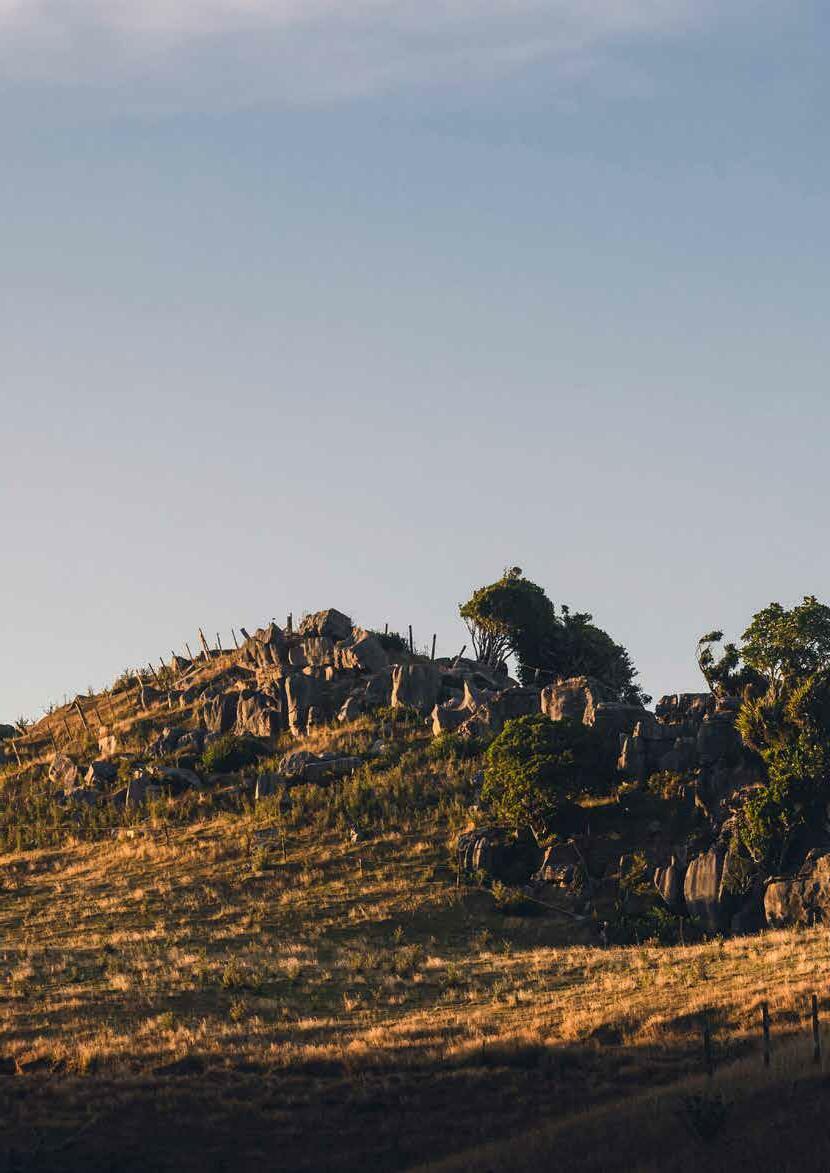
QEII NATIONAL TRUST ANNUAL REPORT 2022 36 FINANCIAL STATEMENTS
Statement of responsibility
The Board is responsible for the preparation of the National Trust’s financial statements and Statement of Performance and for judgements made in them.
The Board has the responsibility for establishing and maintaining a system of internal controls designed to provide reasonable assurances as to the reliability and integrity of financial and nonfinancial reporting.
In the Board’s opinion, these financial statements and Statement of Performance fairly reflect the financial position and operations of the National Trust for the year ended 30 June 2022.
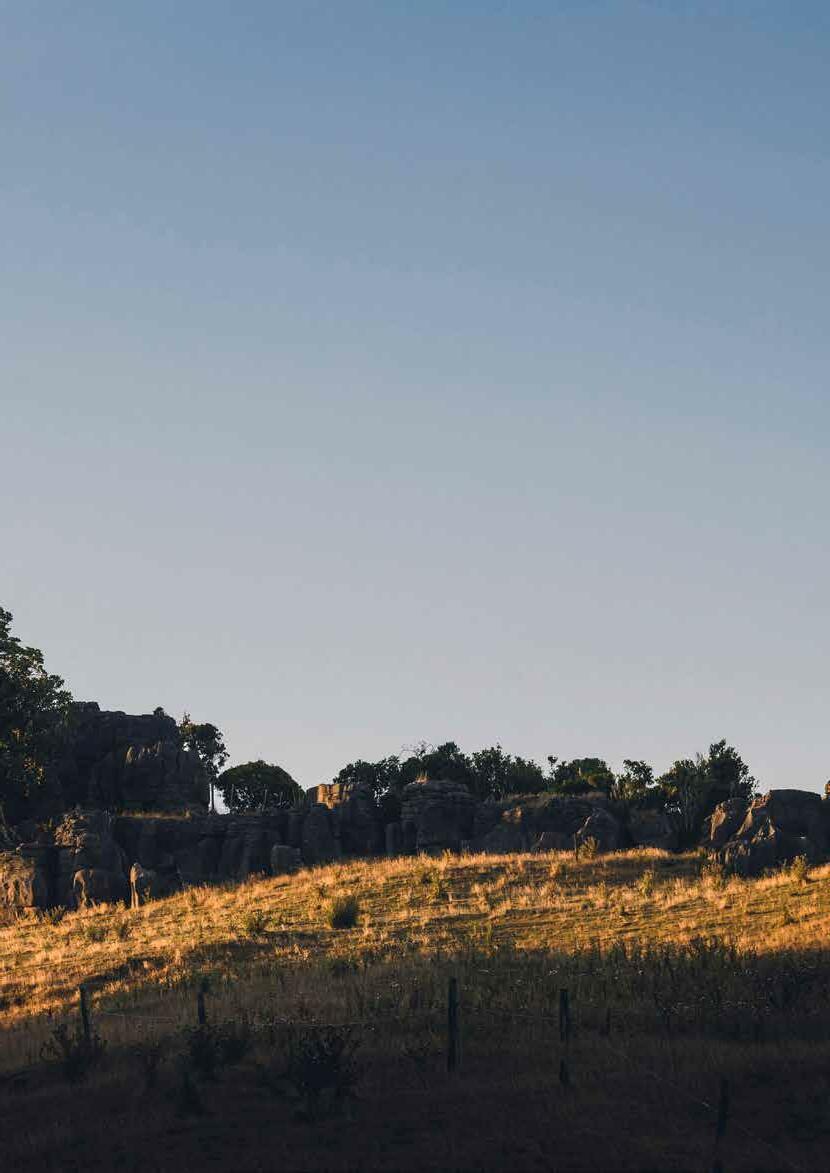
Approval of the financial statements
The Board of Directors has authorised the issue of the financial statements of the Queen Elizabeth II National Trust set out in pages 38 to 52 for the year ended 30 June 2022.
For and on behalf of the Board of Directors, which authorised the financial report on 23 November 2022.
Dated: 23 November 2022
23 November 2022
QEII NATIONAL TRUST ANNUAL REPORT 2022 37
Forever protected
Ngā Kairauhī Papa |
Bruce Wills CHAIR
Graham Mourie DIRECTOR Dated:
STATEMENT OF COMPREHENSIVE REVENUE AND EXPENDITURE FOR THE YEAR ENDED 30 JUNE 2022
Notes
Group 2022 Actual $
Group 2022 Budget $
Group 2021 Actual $
Operating Revenue
Government grant 5,586,000 6,044,000 4,604,069
Contestable funds 387,263 200,000 356,624 Donations and other grants 360,347 300,000 295,724 Other revenue 64,412 93,500 53,887 Operating revenue 6,398,022 6,637,500 5,310,304
Operating Expenditure
Field operations 2,032,968 2,390,259 2,023,138 Covenants 1 1,392,502 2,389,600 1,297,845
Contestable funds 387,263 200,000 356,624 Administration 2 3,444,432 3,649,096 2,898,880 Property operations 157,079 194,660 231,455 Public relations 97,935 204,976 219,970 Depreciation and amortisation 3 70,198 90,000 106,730 Operating expenditure 7,582,377 9,118,591 7,134,641
Net Operating Surplus/(Deficit) (1,184,355) (2,481,091) (1,824,337)
Pre 1995 Fencing provision and costs
Pre 1995 fencing repairs and waivers costs 241,296 118,500 51,955
Pre 1995 movement in fencing provision 13 (1,335,629) 0 (1,069,222)
Net Pre 1995 Fencing provision and costs (1,094,333) 118,500 (1,017,267)
Net investment income 4 (1,470,752) 540,821 1,622,624
Total comprehensive revenue and expenditure (1,560,774) (2,058,770) 815,554
The accompanying notes on pages 42-52 form an integral part of these financial statements.
QEII NATIONAL TRUST ANNUAL REPORT 2022 38 FINANCIAL
STATEMENTS
STATEMENT OF COMPREHENSIVE REVENUE AND EXPENDITURE FOR THE YEAR ENDED 30 JUNE 2022
Explanation of total comprehensive revenue and expenditure
The National Trust concluded the financial year ended 30 June 2022 with total comprehensive revenue and expenditure loss of $1,560,774 against a budgeted total comprehensive revenue and expenditure loss of $2,058,770.
The difference between budgeted and actual total comprehensive revenue and expenditure results primarily from four unbudgeted factors. They are as follows:
I. During the 2022 year, the Department of Conservation funding agreement for 'Jobs for Nature (JFN)' initiative for 'Protecting the Gains' resulted in revenue totaling $1,292k being recognised as income in 'Government Grants' in the Statement of Comprehensive Revenue and Expenditure. The amount of JFN revenue that was recognised was $478k less than budgeted of $1,770k for 2022. The balance of funds invoiced to the end of the year are held in 'Deferred Revenue'. Refer to Note 9 for further information.
II. During the 2022 year, QEII budgeted covenant expenditure of $2.4m for fencing and survey, which was based on up to 171 covenants and related to both QEII business as usual covenants and any covenants created through the JFN Protecting the Gains funding. Whilst the numbers of JFN covenants approved was fewer than budgeted the total number QEII approved covenants for the 2022 year totaled 170.
The actual fencing/survey costs for the 2022 year were $1m less than budgeted, mainly due to the following reasons:
a. While the number of covenants approved (170) was very close to budget, the number registered (104) lagged this figure significantly suggesting delays in the
completion of works required to progress approved covenant to registration. Those works include fencing and surveying, which are significant drivers of QEII covenant expenditure.
We understand that landowners have faced difficulties in procuring fencing contractors and delays accessing fencing materials. QEII has faced similar difficulty in procuring surveyors due to labour shortages and covid-related restrictions. We can expect that these delayed expenditures will be ‘caught-up’ as labour and supply challenges ease.
The unspent costs relating to these delayed covenant establishment works are assumed to be reflected in the $345k increase in ‘Covenant Commitments’ as per note ‘Statement of Commitments’ on page 8.
b. We believe there has been an increase in the level of third-party (mainly local council) offsetting of covenant establishment costs due to QEII securing external funding for the fencing of covenants the exact value of which is difficult to assess this time.
III. For the 2022 year, the pre 1995 fencing provision was based on a roll-forward valuation completed by Deloitte. Overall, there was a $1.3m decrease (2021: $1.2m) in the provision, which was mainly due to the effect of the change in the discount rate curve. Refer to Note 13 for further information.
IV. The net effect of the realised and unrealised gains/ losses on the investment portfolio was a loss of $1.9m (2021: gain of $1.0m) recognised as income in the Statement of Comprehensive Revenue and Expenditure. Refer to Note 4 for further information.
STATEMENT OF CHANGES IN EQUITY FOR THE YEAR ENDED 30 JUNE 2022
At the beginning of the period 15,368,012 13,903,828 14,552,458
Total comprehensive revenue and expenditure (1,560,774) (2,058,770) 815,554
At the end of the period 13,807,238 11,845,058 15,368,012
The accompanying notes on pages 42-52 form an integral part of these financial statements.
QEII NATIONAL TRUST ANNUAL REPORT 2022 39 Ngā Kairauhī Papa | Forever protected
Group
Group
Group 2022 Actual $
2022 Budget $
2021 Actual $
STATEMENT OF FINANCIAL POSITION AS AT 30 JUNE 2022
Note Group 2022 Actual $
Equity
National Trust Equity
Group 2022 Budget $
Group 2021 Actual $
13,807,238 11,845,058 15,368,012
Total Equity 13,807,238 11,845,058 15,368,012
Represented by:
Current assets
Cash and cash equivalents 767,350 13,704 1,267,462 Accounts and other receivables 5 1,366,563 198,302 1,287,795 Investments 6 19,345,705 19,334,842 20,480,797
Total current assets 21,479,618 19,546,848 23,036,054
Less current liabilities
Accounts and other payables 8 836,114 255,443 732,353 Deferred revenue 9 3,115,060 1,099,501 1,874,118
Employee entitlements 180,584 300,000 145,113 Pre 1995 fencing provision 13 1,016,108 1,039,572 1,187,038
Total current liabilities 5,147,866 2,694,516 3,938,622
Working capital 16,331,752 16,852,332 19,097,432
Non-current assets
Property, plant and equipment 10 3,192,085 3,159,501 3,099,264 Intangible assets 12 0 0 0 Total non-current assets 3,192,085 3,159,501 3,099,264
Non-current liabilities
Pre 1995 fencing provision 13 5,716,599 8,166,775 6,828,684 Total non-current liabilities 5,716,599 8,166,775 6,828,684
Net assets 13,807,238 11,845,058 15,368,012
The accompanying notes on pages 42-52 form an integral part of these financial statements.
QEII NATIONAL TRUST ANNUAL REPORT 2022 40 Ngā Kairauhī Papa | Forever protected
STATEMENT OF CASH FLOWS FOR THE YEAR ENDED 30 JUNE 2022
Group 2022 Actual $
Cashflows from operating activities
Group 2021 Actual $
Receipts from operations 7,447,783 4,659,094
Donations and other grants received 79,666 352,142
Interest received 390,573 458,080
Dividends received 179,552 137,647
Other revenue received 28,447 53,767
Payments to suppliers (4,979,403) (4,165,052)
Payments to employees (2,686,482) (2,271,432)
Net cash flow (used in)/from operating activities 460,136 (775,754)
Cash flows from investing activities
Proceeds from sale of investments 3,454,065 4,563,819
Purchase of investments (4,251,294) (4,035,130)
Purchase of property, plant and equipment (163,019) (169,923)
Net cash flow from investing activities (960,248) 358,766
Net cash flows from financing activities 0 0
Net (decrease)/increase in cash and cash equivalents (500,112) (416,988)
Cash and cash equivalents at beginning of period 1,267,462 1,684,450
Cash and cash equivalents at end of period 767,350 1,267,462
STATEMENT OF COMMITMENTS AS AT 30 JUNE 2022
Covenant commitments
Covenant commitments are funds committed to approved covenants still in progress and working towards registration with Land Information New Zealand.
The Stephenson Fund commitments
The Stephenson Fund commitments are funds committed to registered covenant holders to assist them with stewardship on their covenants.
Operating lease commitments
A new agreement to lease level 4 and additional space on level 3 at 138 the Terrace, Wellington dated 31 March 2021 was signed and is effective from 7 May 2021. The term of the lease is six years and three months with two further rights of renewal of three years each.
The landlord offered QEII a rent-free period of three months with two of these relating to the current year.
Capital commitments
STATEMENT OF CONTINGENCIES AS AT 30 JUNE 2022
Group 2022 $
Group 2021 $ 3,980,879 3,635,412 2022 $ 2021 $ 143,827 178,843 2022 $ 2021 $
Less than 1 year 165,340 151,562
Between 1 and 2 years 165,340 165,340 More than 2 years 509,798 675,138 840,478 992,040
The National Trust had no capital commitments as of 30 June 2022 (2021: nil).
The National Trust had no contingent liabilities as at 30 June 2022 (2021: nil).
The accompanying notes on pages 42-52 form an integral part of these financial statements.
QEII NATIONAL TRUST ANNUAL REPORT 2022 41 Ngā Kairauhī Papa | Forever protected FINANCIAL STATEMENTS
Accounting Policies
Reporting entity
Queen Elizabeth the Second National Trust (the National Trust) is a registered charitable organisation that is domiciled in New Zealand and governed by the Queen Elizabeth the Second National Trust Act 1977.
The principal activity of the National Trust is to provide, protect, preserve and enhance open space for the benefit and enjoyment of the people of New Zealand.
Remarkables Station National Trust Limited (100% owned) is a company governed by the Companies Act 1993, is incorporated in New Zealand and has registered charitable status. The principal activity is to own and manage the Remarkables Station farm which was gifted to QEII from the Jardine Foundation on 1 July 2022.
The financial statements of the National Trust (and its subsidiary Remarkables Station National Trust Limited) for the year ended 30 June 2022 were authorised for issue by the Board on 23rd of November 2022.
Statement of compliance
The financial statements have been prepared in accordance with Queen Elizabeth the Second Trust Act 1977 which requires compliance with Generally Accepted Accounting Practice in New Zealand (“NZ GAAP”).
As the primary objective of the National Trust is to protect special places for the benefit of present and future generations, rather than making a financial return, the National Trust is a public benefit entity for the purpose of financial reporting.
The financial statements of the National Trust have been prepared in accordance with Tier 2 Public Benefit Entity (‘PBE”) standards and disclosure concessions have been applied. The National Trust is eligible to report in accordance with Tier 2 PBE standards because it does not have public accountability and its expenditure is between $2m and $30m and therefore not considered large in accordance with XRB A1 Accounting Standards Framework.
Measurement base
The financial statements have been prepared on a historical cost basis, except for investments which have been measured at fair value and the pre 1995 fencing liability which is valued annually.
The financial statements are presented in New Zealand dollars. The accounting policies set out below have been applied consistently to all periods presented in these financial statements.
Basis of consolidation
Group
The financial statements comprise the financial statements of QEII National Trust (QEII) and its subsidiary (the Group) as at 30 June 2022.
QEII (the parent) has control of the subsidiary through its 100% ownership which gives the parent the: power to direct the relevant activities of the subsidiary exposure, or rights, to variable benefits from its involvement with the subsidiary
• ability to use its power over the subsidiary to affect the nature and amount of the benefits from its involvement with the subsidiary.
Consolidation of a subsidiary begins when the Group obtains control over the subsidiary and ceases when the Group loses control of the entity. Assets, liabilities, revenue and expenses of a subsidiary acquired or disposed of during the year are included in the financial statements from the date the Group gains control until the date the Group ceases to control of the subsidiary.
The surplus or deficit and each component of other comprehensive of revenue and expense are attributed to the owners of the subsidiary. When necessary, adjustments are made to the financial statements of subsidiary to bring its accounting policies into line with the Group’s accounting policies. All intra-economic entity assets and liabilities, net assets/equity, revenue, expenses and cash flows relating to transactions between entities of the economic entity are eliminated in full upon consolidation.
A change in the ownership interest of a subsidiary that does not result in a loss of control, is accounted for as an equity transaction. If the Group loses control over the subsidiary, it derecognises the assets (including goodwill) and liabilities and other components of net assets/equity, while any resulting gains or losses are recognised in surplus or deficit. Any investment retained in the former subsidiary is recognised at fair value.
QEII National Trust Investment in the subsidiary held by QEII are accounted for at cost less any impairment charges in the separate financial statements of the QEII.
Dividends and other distributions from subsidiary are recognised as revenue in QEII’s separate statement of financial performance, but only to the extent that these distributions are received and receivable from the subsidiary’s accumulated comprehensive revenue and expense arising after acquisition. Such distributions do not impact the recorded cost of the investment.
At the end of each reporting period, QEII assesses whether there are any indicators that the carrying value of the investment in subsidiary may be impaired. Where such indicators exist, to the extent that the carrying value of the investment exceeds its recoverable amount, an impairment loss is recognised.
QEII NATIONAL TRUST ANNUAL REPORT 2022 42
NOTES TO THE FINANCIAL STATEMENTS FOR THE YEAR ENDED 30 JUNE 2022
Capital management
The National Trust’s capital is represented by its net assets. It manages and maintains its capital by prudently managing revenue, expenses, and assets and liabilities to ensure it effectively achieves its objectives and purpose, while still remaining a going concern.
Revenue
The National Trust’s revenue is mainly from non-exchange transactions. They are as follows:
Grants revenue from Government or government agencies - grants revenue is recognised as it becomes receivable, except where a grant is for a specific purpose and there is an obligation to repay it if the specific purpose is not undertaken. In this situation, revenue is deferred until the obligations are performed.
Interest and dividend revenue (investment income) – interest income is recognised as earned, dividend income is recognised when the right to receive payment is established.
Donations and other grants revenue – cash donations are recognised when received, non-cash donations are recognised at their fair value at the time that ownership rights are transferred to the National Trust.
Membership/sponsorship revenue – membership/ sponsorship revenue is recognised when the cash is received.
Property, plant and equipment
Land and improvements acquired or gifted to the National Trust are recorded at cost for acquired assets, or at fair value for gifted assets.
The cost of new fencing on National Trust properties is capitalised in the year of completion.
Property, plant and equipment (other than land) is measured at cost, less accumulated depreciation and impairment losses. Land is not depreciated.
Restrictions on assets
The only restrictions on assets held by the National Trust are those pertaining to covenants and specific gifts.
Depreciation
Depreciation is charged on a straight-line basis over the useful life of the assets. Depreciation is charged at rates calculated to allocate the cost of the asset less any estimated residual values over its remaining useful life:
Computer and electronic equipment 3 years
Intangible assets 5 years
Furniture and fittings, plant and equipment 5 - 10 years
Buildings and improvements 25-50 years (gifted and purchased buildings)
Land fencing 40 years
Leasehold improvements Life of the Lease
Employment Entitlements
Employee entitlements that the National Trust expects to be settled within 12 months of the balance date are measured at undiscounted nominal values based on accrued entitlements at the current rate of pay. These include salaries and wages accrued up to balance date and annual leave earned, but not yet taken at balance date.
Provisions
Provisions are recognised when the National Trust has a present obligation (legal or constructive) as a result of a past event, it is probable that an outflow of resources embodying economic benefits or service potential will be required to settle the obligation and a reliable estimate can be made of the amount of the obligation.
The expense relating to any provision is presented in the Statement of Comprehensive Revenue and Expenditure.. Goods and services tax
All amounts are shown exclusive of goods and services tax (GST), except where receivables and payables are stated as GST inclusive.
Financial instruments
Non-derivative financial instruments comprise investments, accounts and other receivables, cash and cash equivalents, accounts and other payables, and other current liabilities. Non-derivative financial instruments are recognised at fair value. Financial instruments not at fair value are recognised through the Statement of Comprehensive Revenue and Expenditure, with transaction costs attributable to the acquisition.
A financial instrument is recognised if the National Trust becomes a party to the contractual provisions of the instrument. Financial assets are derecognised if our contractual rights to the cash flows from the financial asset expire or if we transfer the financial asset to another party without retaining control or retaining substantially all risks and rewards of the asset.
The National Trust holds a significant level of bonds and shares as investments. These financial assets are designated upon initial recognition by the National Trust as at fair value through surplus or deficit.
Subsequent to initial recognition, financial instruments at fair value through surplus or deficit are measured at fair value, and changes therein are recognised in the surplus or deficit. Fair value is quoted at market value at balance date.
Cash and cash equivalents include cash on hand, deposits held on call with banks and other short-term highly liquid investments with original maturities of three months or less from the date of acquisition.
QEII NATIONAL TRUST ANNUAL REPORT 2022 43 Ngā Kairauhī Papa | Forever protected NOTES TO THE FINANCIAL STATEMENTS FOR THE YEAR ENDED 30 JUNE 2022
Accounts and other receivables are classified as loans and receivables and are recognised at amortised cost using the effective interest method less impairment. Accounts and other payables and other current liabilities are classified as other liabilities and are carried at amortised cost using the effective interest method.
Foreign currency
Transactions in foreign currencies are translated at the rates on the date of the transaction. Transactions in foreign currency that are not settled in the accounting period, resulting in monetary assets and liabilities denominated in foreign currencies at balance date, are translated to NZD at the foreign exchange rate ruling at that date. Foreign exchange differences arising on their translation are recognised in the Statement of Comprehensive Revenue and Expenditure.
Financial risk management
The National Trust's principal financial instruments comprise cash and cash equivalents and bonds and shares held as part of its normal operations. The National Trust has a policy to only invest in highly liquid investments with a Standard & Poor's or equivalent rating of 'AAA to BBB+'. Equities must be recommended by a registered financial planner or be a recognised investment fund for use by charitable trusts.
The National Trust has various other financial instruments such as receivables and payables, which arise directly from its operations.
1. Covenant expenditure
Leases
Operating lease payments, where the lessors effectively retain substantially all the risks and benefits of ownership of the leased items, are charged as expenses in the periods in which they are incurred.
Commitments
Future expenses and liabilities to be incurred on contracts that have been entered into at balance date are disclosed as commitments to the extent that there are equally unperformed obligations.
Contingent liabilities
Contingent liabilities are disclosed at the point at which the contingency is evident.
Budget figures
The budget figures shown in the financial statements are those that were approved by the Board of Directors.
Comparative year figures
Some comparative year figures have been reclassified to be consistent with their classification in 2022 with the pre 1995 fencing costs and movements being presented separately from operating activities.
Covenant expenditure relates to fencing, survey and legal costs incurred on approved covenants as they progress towards registration and as a contribution to stewardship of covenanted land.
Group 2022 $
Group 2021 $
Fencing 681,971 617,065 Survey 432,220 420,977
Weed and pest control 70,073 50,831
Revegetation 16,500 28,074
Repairs and Maintenance 8,984 0
Project Management - JFN projects 20,342 0
The Stephenson Fund 160,412 180,898
Total covenant expenditure 1,392,502 1,297,845
During the year to 30 June 2022, a seventh round of The Stephenson Fund (TSF) was offered to support covenantors with strategically important enhancement projects that have been planned for their covenants (2021: 6th round). A total of $197,642 was allocated to 31 TSF applicants in the 7th round (2021: 6th round - 30 TSF applicants with $150,377 allocated). The remaining unspent amounts at 30 June 2022 are included in the TSF amount showing in the Statement of Commitments.
The key objective of The Stephenson Fund is to provide support for enhanced covenant stewardship through projects that protect, restore and manage a covenant’s open space values. Grants ranging from $2,000 up to a maximum amount of $15,000 plus GST (if GST registered) are available with applicants being required to match the grant amount either financially or through in-kind contributions, apart from applications submitted due to hardship which may receive funding up to 100% of project costs.
QEII NATIONAL TRUST ANNUAL REPORT 2022 44 NOTES TO THE FINANCIAL STATEMENTS FOR THE YEAR ENDED 30 JUNE 2022
2. Administration expenditure
Group 2022 Actual $
Group 2021 Actual $
Directors' fees 29,998 27,449
Remuneration of key management personnel* 729,190 776,813
Employee entitlements # 2,002,719 1,500,578 Audit fees 79,500 35,485
Rental expenses 165,451 87,853
Doubtful debts 0 3,080
Loss on disposal of plant and equipment 0 10
Other administration expenses 437,575 467,612
Total administration expenditure 3,444,432 2,898,880
* Key management personnel:
During the 2022 year, the Senior Leadership Team (SLT) is made up of the CE and three (2021: three) senior managers.
# Employee entitlements (and key management personnel costs):
Ahead of signing the Jobs for Nature 'Protecting the gains' funding agreement with the Department of Conservation in June 2021, QEII completed a restructure of head office in December 2020 in anticipation of signing the funding agreement.
As at 30 June 2022 all seven staff positions were filled (2021: five positions). The annual cost of filling those positions for the year to 30 June 22 has resulted in a 24% increase in employee entitlements compared with actual 2021 year.
3. Depreciation and amortisation
Group 2022 Actual $
Group 2021 Actual $
Depreciation has been charged on the following classes of asset: Furniture and fittings, plant and equipment, computer and electronic equipment 48,619 80,803 Improvements 20,559 19,910 Land fencing 1,020 1,020
Amortisation has been charged on: Intangible assets 0 4,997
Total depreciation and amortisation expenditure 70,198 106,730
QEII NATIONAL TRUST ANNUAL REPORT 2022 45 Ngā Kairauhī Papa | Forever protected NOTES TO THE FINANCIAL STATEMENTS FOR THE YEAR ENDED 30 JUNE 2022
4. Net investment income
Group 2022 Actual $
Group 2021 Actual $
Interest 376,497 439,940 Dividends 179,552 137,647
Discount rate unwind on pre 1995 fencing provision (52,614) 121,403 Net realised/unrealised gains/losses (1,932,321) 970,546
Investment fees (41,866) (46,912) Net investment income (1,470,752) 1,622,624
Investment income comprises interest, dividend income, and changes in the fair value of financial assets at the fair value through the Statement of Comprehensive Revenue and Expenditure and foreign currency gains.
Investment expenditure comprises foreign currency losses and changes in the fair value of financial assets at the fair value through the Statement of Comprehensive Revenue and Expenditure. Investment expenses also include any fees and transaction costs associated with maintaining the investment portfolio.
5. Accounts and other receivables
Group 2022 Actual $
Group 2021 Actual $
Accounts receivable 1,360,411 1,290,792
Less Provision for doubtful debts 0 0 1,360,411 1,290,792
Interest receivable 69,075 83,151 GST receivable (62,923) (86,148)
Total accounts and other receivables 1,366,563 1,287,795
6. Investments
Group 2022 Actual $
Group 2021 Actual $
Fixed interest - corporate bonds 9,866,995 10,744,366
Term deposits 604,964 945,000 Equities - Australia/New Zealand 4,612,369 4,593,711
Property Equities - Australia/New Zealand 407,980 407,980 Equities - International 3,853,397 3,789,740
Total investments 19,345,705 20,480,797
QEII NATIONAL TRUST ANNUAL REPORT 2022 46 NOTES TO THE FINANCIAL STATEMENTS FOR THE YEAR ENDED 30 JUNE 2022
7. Investment in a subsidiary
Remarkables Station National Trust Limited (RSNTL) was incorporated on 26th January 2021. The shareholding is made up of one share for no consideration. RSNTL is a wholly owned subsidiary of QEII with charitable and tax-exempt status in line with its owner, QEII.
During the year ended 30 June 2022, a number of transactions have been on-charged on an invoice at cost between the two entities. As at 30 June 2022, RSNTL's Statement of Financial Position shows an amount owed to QEII in Accounts Payable of $98k. This has been consolidated out in the 2022 Group accounts in notes 5 and 8.
No further amounts are owing between the two entities as at 30 June 2022.
The reporting date of QEII and its subsidiary is 30 June.
8. Accounts and other payables
Group 2022 Actual $
Group 2021 Actual $
Accounts payable 602,211 596,341
Accrued trade payables 233,903 136,012
Total accounts and other payables 836,114 732,353
9. Deferred revenue
Group 2022 Actual $
Group 2021 Actual $
Deferred revenue 3,115,060 1,874,118
Made up of:
a) Contestable Funds
* 1 individual projects from Lotteries Environment and Heritage Fund
* 48 individual projects from council funds
* 1 individual project MPI fund
Contestable funds have been approved for specific projects as stated in the project deeds. Some projects may take longer than a year to complete. At the end of each financial year money received for projects that has not been spent for the designated purpose and that has a return obligation (if unspent) is reported as deferred revenue.
Group 2022 Actual $
Group 2021 Actual $
Total contestable deed amounts
2,658,024 1,411,723
Project income to date 2,647,892 1,407,450
Deferred revenue relating to contestable funds 1,565,382 606,477
b) Department of Conservation (DOC) - Jobs for Nature projects
Funding Agreements have been executed with the DOC for three Jobs for Nature projects. Each of the three projects is planned to take longer than a year to complete. At the end of each financial year money received for projects that has not been spent for the designated purpose and that has a return obligation (if unspent) is reported as deferred revenue.
QEII NATIONAL TRUST ANNUAL REPORT 2022 47 Ngā Kairauhī Papa | Forever protected NOTES TO THE FINANCIAL STATEMENTS FOR THE YEAR ENDED 30 JUNE 2022
The three approved projects are as follows:
I.
Protecting the Gains (PTG):
In June 2021, a four-year agreement between QEII and the DOC was signed. The project aims to apply QEII protection to land where other Jobs for Nature investment has been made by government (either DOC or other Crown agency investments). This protection will consist of either a QEII openspace covenant (OSC) or a Restoration Agreement (RA) which is a new form of legal protection that has been developed as part of the PTG project.
II. Deer Eradication Project (DEP):
In September 2021 QEII and DOC agreed a three year project to undertake the deer eradication project, which aims to exclude deer from a number of registered openspace covenants (OSC) in 10 regions around the North and South Islands. The selected OSC are identified as having high biodiversity values to which deer present a significant threat. Due to various issues including the difficulty in recruiting staff, the project did not start until April 2022.
III. Eastern South Island Rare and Threatened Species and Habitats project (ESI):
In December 2021, a three-year agreement was concluded between QEII and DOC to assist with the protection of rare and threatened species on up to 40 OSC in the ESI. This project is for $1m over three years. Due to various issues including the difficulties in contracting a project manager to assist QEII, the project did not start until June 2022.
PTG DEP ESI
Project life 4 years 3 years 3 years
Group 2022 Actual $
Group 2021 Actual $
Total DOC deed amounts 8,000,000 2,000,000 1,000,000 11,000,000 8,000,000
Project income to date 1,622,070 15,000 5,000 1,642,070 330,070
Deferred revenue relating to DOC Jobs for nature projects 677,930 238,800 29,000 945,730 669,930
c) An estate bequest held
The National Trust holds a large cash bequest from an estate valued at $605k including interest received on the funds to 30 June 2022 (2021: $595k). The estate deed included a clause requiring the funds be used to purchase an area of land. Until a suitable area of land that meets the requirement of the estate can be purchased by the National Trust, the funds will be held as 'deferred revenue'. The relevant clause in the estate deed requires full repayment of these funds if a suitable area of land cannot be purchased within a five-year timeframe.
10. Property, plant and equipment Group
Land Actual $
Buildings and Improvements Actual $
Fencing Actual $
Other Actual $
Total Actual $
Cost at beginning of year 2,461,501 824,000 84,925 534,100 3,904,526
Accumulated depreciation 0 (317,735) (67,063) (420,465) (805,263) Net book value at beginning of year 2,461,501 506,265 17,862 113,635 3,099,263
Acquisitions 0 6,827 7,909 148,284 163,020
Disposals * 0 0 0 0 0
Depreciation 0 (20,559) (1,020) (48,619) (70,198) Net book value at end of year 2,461,501 492,533 24,751 213,300 3,192,085
Cost at end of year 2,461,501 830,827 92,834 682,384 4,067,546
Accumulated depreciation 0 (338,294) (68,083) (469,084) (875,461) Net book value at end of year 2,461,501 492,533 24,751 213,300 3,192,085
QEII NATIONAL TRUST ANNUAL REPORT 2022 48
TO THE FINANCIAL STATEMENTS FOR THE YEAR ENDED 30 JUNE 2022
NOTES
* Disposals are reported net of accumulated depreciation.
Other assets consist of furniture, plant and equipment, computer equipment and electronic equipment.
During the year ended 30 June 2022, the following improvements were made to QEII owned properties:
1) additional steps were put in place at Mokotahi Hill on Mahia Peninsula to ensure that there are sufficient steps for visitors to access the site. The cost for this was $5.6k.
2) the final consent costs relating to the new bridge at Dunn's Bush was paid. The cost for this was $1.1k.
During the year ended 30 June 2022, the following head office improvements were made, and office equipment was purchased:
3) remodeling of level 4, 138 The Terrace, Wellington to accommodate the additional staff resulting from the December 2020 restructure with additional work completed on level 3 to set up meeting rooms and the board room to replace the ones removed in the level 4 remodel. The cost of this work was $74.7k.
4) new computer equipment, desks, chairs and meeting room equipment was purchased to support the increase in staff numbers and the remodel of head office at a cost of $69.4k.
11. Land and improvements Group
Land Actual $
Buildings and Improvements Actual $
2022 Total Actual $
2021 Total Actual $
Aroha Island 425,000 217,538 642,538 661,275
Awapikopiko Reserve 42,000 22,600 64,600 65,744
Bowman's Bush 63,000 0 63,000 63,000
Dunn's Bush 150,000 34,413 184,413 183,903
Ernest Morgan Forest Reserve 140,000 0 140,000 140,000
Hann Bush 18,000 0 18,000 18,000
I'Anson Reserve 434,000 56,370 490,370 490,370
Ira Menzies Duneland 250,000 0 250,000 250,000
Mara Point 80,000 0 80,000 80,000
Maungaruahine Bush 74,000 0 74,000 74,000
Miro Bay 100,000 0 100,000 100,000
Mokotahi Hill 9,000 161,612 170,612 164,972
Parkinson's Bush 143,000 0 143,000 143,000
Pouawa Sandhills 66,000 0 66,000 66,000
Robb's Bush 33,500 0 33,500 33,500
Robert Houstin Memorial Reserve 50,000 0 50,000 50,000
Sheps Park 1 0 1 1
Snell's Bush 36,000 0 36,000 36,000
Spencer Reserve 16,000 0 16,000 16,000
Sunset Bay 45,000 0 45,000 45,000
Tata Headland 17,000 0 17,000 17,000
Taupō Swamp 98,000 0 98,000 98,000
Te Harakiki Swamp 32,000 0 32,000 32,000
Tumutumu Bush 115,000 0 115,000 115,000
Waiata Bush 25,000 0 25,000 25,000
Lake Wainamu (vested) 0 0 0 0
Total land and improvements
2,461,501 492,533 2,954,034 2,967,766
QEII NATIONAL TRUST ANNUAL REPORT 2022 49 Ngā Kairauhī Papa | Forever protected
TO THE FINANCIAL
THE YEAR
NOTES
STATEMENTS FOR
ENDED 30 JUNE 2022
All land (including improvements) is subject to restrictions on use as set out in the original deeds of gift or covenant.
12. Intangible assets
Group 2022 Actual Software $
Cost at beginning of year 264,548
Accumulated amortisation (264,548) Net book value at beginning of year (0) Acquisitions/(Disposals) 0 Amortisation 0 Net book value at end of year (0)
Cost at end of year 264,548
Accumulated amortisation (264,548) Net book value at end of year (0)
Intangible assets consist mainly of the National Trusts web-based covenant management system developed to improve the covenanting process.
13. Pre 1995 fencing provision
Group 2022 Actual $
Group 2021 Actual $
Provision at the beginning of the year 8,015,722 9,206,347 Unused amounts reversed (12,142) (69,303) Amounts used 241,296 51,955 Discount rate unwind + 52,614 (121,403)
Experience variance (32,243) 1,112,495
Effect of change in the inflation rate curve 33,301 617,850 Effect of change in the discount rate curve (1,565,841) (2,782,219)
Provision at the end of the year 6,732,707 8,015,722
(Decrease) in provision (1,283,015) (1,190,625)
Split between:
Current liabilities 1,016,108 1,187,038 Non-current liabilities 5,716,599 6,828,684 6,732,707 8,015,722
The National Trust has a provision to contribute to fencing in perpetuity in some covenants agreed before 1995. The fences are mostly maintained by landowners on a day-to-day basis. It is
QEII NATIONAL TRUST ANNUAL REPORT 2022 50
TO THE FINANCIAL
FOR THE YEAR ENDED 30 JUNE 2022
NOTES
STATEMENTS
the Trust's objective to reduce the provision over time.
+ The discount rate unwind forms part of the Investment Income note. Please refer to Note 4. The experience variance adjustment is due to:
* an decrease in the provision of $27k due to the updated fence information: and
* an increase in the provision of $251k due to the updated cost per metre of fence: and
* an decrease in the provision of $256k due to the assumption that fences with a replacement date prior to the valuation date are expected to have their fences replaced in the coming year.
Based on history and expectations there will be some level of costs to meet these covenants each year for the foreseeable future.
The main areas of uncertainty in the calculation of the reasonable estimate are:
1) Fence lifetime (currently estimated to be 40 years) and the timing of replacement of particular lengths of fencing.
2) Cost of fencing per metre - $21.70 per metre. The cost per metre was used as a base assumption and inflated using CPI forecasts as at 30 June 2022, consistent with the methodology used in the 2020 valuation. In 2021, the cost per metre was $20.89 per metre which was based on the updated actual cost of a metre of fencing for the three years ended 30 June 2021.
3) The discounted future cash flows back to the valuation date uses the risk-free discount rate curve published by the New Zealand Treasury as at 30 June 2022.
4) An inflation rate assumption is that the future cost per metre will increase in line with the New Zealand Treasury CPI forecast as at 30 June 2022.
5) The fencing assumption - the percentage of those fences where the National Trust has a contractual obligation to contribute to the replacement cost, which the National Trust expects will need replacing, and where the landowner will ask the National Trust to contribute to the cost of replacing the fence (currently as assumption of 37.5% has been adopted based on a probability weighting) (2021: 37.5%).
Effectively the calculation estimates the costs each year in the future then discounts the cost back to 30 June 2022 to reflect what the final cost will be in today's dollars.
It is expected that some of the National Trust's investment portfolio will be used to fund the pre 1995 fencing provision. However, investment income (interest and realised gains) from the portfolio have not been taken into account when calculating the pre 1995 fencing provision so the net costs to the organisation are likely to be lower.
Sensitivity analysis
Variable Change 2022 2021
Discount rate +1.00% -0.50% -1.00%
-$1.6m +$1.4m +$3.9m
-$2.1m +$1.9m +$5.3m
Take-Up Factor +20% -20% +$3.6m -$3.6m +$4.3m -$4.3m
Cost per metre +10% -10% +$0.7m -$0.7m +$0.8m -$0.7m
A percentage increase/decrease in any of the variables above would result in the following:
* a decrease/increase in the pre 1995 Fencing provision liability
* a decrease/increase in the covenant expenditure
QEII NATIONAL TRUST ANNUAL REPORT 2022 51 Ngā Kairauhī Papa | Forever protected NOTES TO THE FINANCIAL STATEMENTS FOR THE YEAR ENDED 30 JUNE 2022
* a decrease/increase in equity for the amount indicated in the table above.
14. Related party transactions
During the 2022 year, QEII paid $7,510 (2021: $nil) made up of $5,510 for QEII's share of a fence and $2,000 for weed and pest control on new covenants on Cleardale Station Limited. Donna Field is a QEII and RSNTL director and also a shareholder/director of Cleardale Station Limited.
During the 2022 year, QEII paid $9,108 (2021: $nil) to the RJ and K Schumacher partnership for their application to the Stephenson Fund for track work completed on their property. Karen Schumacher, a QEII director is also a partner in the RJ and K Schumacher partnership.
During the 2022 year, QEII did not pay any amounts to QEII director Alan Livingston compared to 2021 when QEII paid $4,680 to him for the repair to a pre 1995 fence on a covenant.
There were no other payments to or receipts from related parties during the 2022 year other than payments to Key Management Personnel and director’s fees.
15. Events after balance date
In September 2020, QEII signed an Endowment Deed with the Jardine Foundation to accept the gift of the Remarkables Station in Queenstown. At a QEII board meeting in November 2020, the constitution of Remarkables Station National Trust Limited (RSNTL) was approved with intention that this company was incorporated to accept this gift from the Jardine Foundation in late 2022.
A Distribution Deed from the Jardines Foundation Remarkables Station was signed by the Jardines and QEII board representatives to make a gift via an in-specie distribution of the Remarkables Station to Remarkables Station National Trust Limited (RSNTL).
RSNTL is a beneficiary of the Dickson and Jillian Jardine Foundation and by signing the deed had agreed to receive a transfer of land noted in the deed. In addition, RSNTL agreed to register the Remarkables Station land as a covenant once a subdivision to exclude two small parcels of land was completed. The date of distribution is to be 1st July 2022.
16. The effects of Covid-19 on the National Trust
Covid-19 continued to cause disruption and anxiety around the world and here in Aotearoa New Zealand. However, in the past year QEII staff and regional reps having shown resilience and courage as we head into a new phase where we are learning to live with Covid-19.
In August 2021 Aotearoa was plunged back into a level 4 lockdown, which continued in the Auckland area until December 2021. This affected the ability of our regional representatives to visit our current and potential covenantors in their areas. The rest of the country was in level 2 during this time which did not greatly affect workflows although some were still uncertain about travelling and mingling with others.
In February 2022, the Omicron strain of Covid-19 emerged in Aotearoa and since then many QEII staff and regional representatives have fallen ill with the Covid-19 virus. This has resulted in people being unwell anywhere from a few days to many weeks – affecting productivity in some areas and delaying the progress of some projects. Fortunately none of our team have suffered very serious or permanent health impacts from Covid-19.
The new traffic light framework was put in place in December 2021. On 12th September 2022, the NZ government removed the traffic light framework with the requirement to wear masks high-risk settings (such as health and aged care facilities) and for those who test positive for Covid-19 selfisolating for seven days.
Around the world and here in Aotearoa there continue to be a number of other economic issues (inflation and increasing interest rates) which have flowed on from the worldwide pandemic. These have begun to affect QEII with some increases in prices and in staff recruitment issues. To date there has not been a significant impact on the National Trust's financial performance or position.
The effect on our operations of Covid-19 is reflected in these financial statements, based on the information available to the date these financial statements are signed.
QEII NATIONAL TRUST ANNUAL REPORT 2022 52 NOTES TO THE FINANCIAL STATEMENTS FOR THE YEAR ENDED 30 JUNE 2022
INDEPENDENT AUDITOR’S REPORT
TO THE READERS OF THE QUEEN ELIZABETH THE SECOND NATIONAL TRUST’S FINANCIAL STATEMENTS FOR THE YEAR ENDED 30 JUNE 2022
The Auditor General is the auditor of the Queen Elizabeth The Second National Trust (the Trust). The Auditor General has appointed me, Sam Nicolle, using the staff and resources of Ernst & Young, to carry out the audit of the financial statements of the Trust on his behalf.
Opinion
We have audited the financial statements of the Trust on pages 38 to 52, that comprise the statement of financial position as at 30 June 2022, the statement of comprehensive revenue and expenses, statement of changes in equity and statement of cash flows for the year ended on that date and the notes to the financial statements including a summary of significant accounting policies; and
In our opinion, the financial statements of the Trust on pages 38 to 52:
• present fairly, in all material respects:
o its financial position as at 30 June 2022; and
o its financial performance and cash flows for the year then ended; and
• comply with generally accepted accounting practice in New Zealand in accordance with the Public Benefit Entity Standards with disclosure concessions
Our audit was completed on 25 November 2022. This is the date at which our opinion is expressed. The basis for our opinion is explained below. In addition, we outline the responsibilities of the Directors and our responsibilities relating to the financial statements, we comment on other information, and we explain our independence.
Basis for our opinion
We carried out our audit in accordance with the Auditor-General’s Auditing Standards, which incorporate the Professional and Ethical Standards and the International Standards on Auditing (New Zealand) issued by the New Zealand Auditing and Assurance Standards Board. Our responsibilities under those standards are further described in the Responsibilities of the auditor section of our report. We have fulfilled our responsibilities in accordance with the Auditor-General’s Auditing Standards.
We believe that the audit evidence we have obtained is sufficient and appropriate to provide a basis for our opinion.
A member firm of Ernst & Young Global Limited
QEII NATIONAL TRUST ANNUAL REPORT 2022 53
Responsibilities of the Directors for the financial statements
The Directors are responsible on behalf of the Trust for preparing financial statements that are fairly presented and that comply with generally accepted accounting practice in New Zealand.
The Directors are responsible for such internal control as they determine is necessary to enable the preparation of financial statements that are free from material misstatement, whether due to fraud or error.
In preparing the financial statements, the Directors are responsible on behalf of the Trust for assessing the Trust’s ability to continue as a going concern. The Directors are also responsible for disclosing, as applicable, matters related to going concern and using the going concern basis of accounting, unless the Directors intend to wind up the Trust or to cease operations, or have no realistic alternative but to do so.
Responsibilities of the auditor for the audit of the financial statements
Our objectives are to obtain reasonable assurance about whether the financial statements, as a whole, are free from material misstatement, whether due to fraud or error, and to issue an auditor’s report that includes our opinion.
Reasonable assurance is a high level of assurance, but is not a guarantee that an audit carried out in accordance with the Auditor General’s Auditing Standards will always detect a material misstatement when it exists. Misstatements are differences or omissions of amounts or disclosures, and can arise from fraud or error. Misstatements are considered material if, individually or in the aggregate, they could reasonably be expected to influence the decisions of readers taken on the basis of these financial statements.
For the budget information reported in the financial statements and the performance information, our procedures were limited to checking that the information agreed to the Trust’s 2021/2022 Budget.
We did not evaluate the security and controls over the electronic publication of the financial statements.
As part of an audit in accordance with the Auditor General’s Auditing Standards, we exercise professional judgement and maintain professional scepticism throughout the audit. Also:
• We identify and assess the risks of material misstatement of the financial statements, whether due to fraud or error, design and perform audit procedures responsive to those risks, and obtain audit evidence that is sufficient and appropriate to provide a basis for our opinion. The risk of not detecting a material misstatement resulting from fraud is higher than for one resulting from error, as fraud may involve collusion, forgery, intentional omissions, misrepresentations, or the override of internal control.
• We obtain an understanding of internal control relevant to the audit in order to design audit procedures that are appropriate in the circumstances, but not for the purpose of expressing an opinion on the effectiveness of the Trust’s internal control.
• We evaluate the appropriateness of accounting policies used and the reasonableness of accounting estimates and related disclosures made by the Directors.
A member firm of Ernst & Young Global Limited
54
• We conclude on the appropriateness of the use of the going concern basis of accounting by the Directors and, based on the audit evidence obtained, whether a material uncertainty exists related to events or conditions that may cast significant doubt on the Trust’s ability to continue as a going concern. If we conclude that a material uncertainty exists, we are required to draw attention in our auditor’s report to the related disclosures in the financial statements or, if such disclosures are inadequate, to modify our opinion. Our conclusions are based on the audit evidence obtained up to the date of our auditor’s report. However, future events or conditions may cause the Trust to cease to continue as a going concern.
• We evaluate the overall presentation, structure and content of the financial statements, including the disclosures, and whether the financial statements represent the underlying transactions and events in a manner that achieves fair presentation.
We communicate with the Directors regarding, among other matters, the planned scope and timing of the audit and significant audit findings, including any significant deficiencies in inter nal control that we identify during our audit.
Our responsibilities arise from the Public Audit Act 2001.
Other information
The Directors are responsible for the other information. The other information comprises the information included on pages 2 to 37, but does not include the financial statements, and our auditor’s report thereon.

Our opinion on the financial statements does not cover the other information and we do not express any form of audit opinion or assurance conclusion thereon.
In connection with our audit of the financial statements, our responsibility is to read the other information. In doing so, we consider whether the other information is materially inconsistent with the financial statements or our knowledge obtained in the audit, or otherwise appears to be materially misstated. If, based on our work, we conclude that there is a material misstatement of this other information, we are required to report that fact. We have nothing to report in this regard.
Independence
We are independent of the Trust in accordance with the independence requirements of the Auditor General’s Auditing Standards, which incorporate the independence requirements of Professional and Ethical Standard 1: International Code of Ethics for Assurance Practitioners issued by the New Zealand Auditing and Assurance Standards Board.
Other than the audit, we have no relationship with, or interests in, the Trust.
Sam Nicolle Ernst & Young Chartered Accountants
On behalf of the Auditor General Wellington, New Zealand
A member firm of Ernst & Young Global Limited
QEII NATIONAL TRUST ANNUAL REPORT 2022 55

Level 4, 138 The Terrace, PO Box 3341, Wellington 6140, New Zealand Phone 04 472 6626 | info@qeii.org.nz qeiinationaltrust.org.nz












































